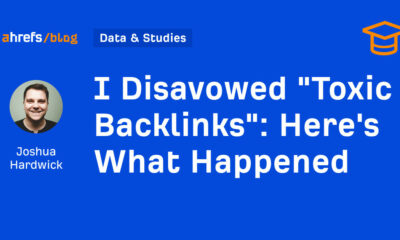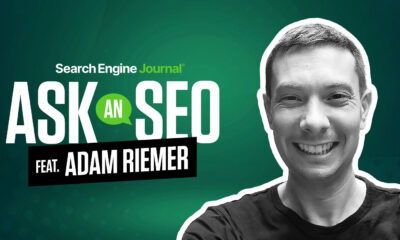SEO
Google Search Console Adds INP To Core Web Vitals Report
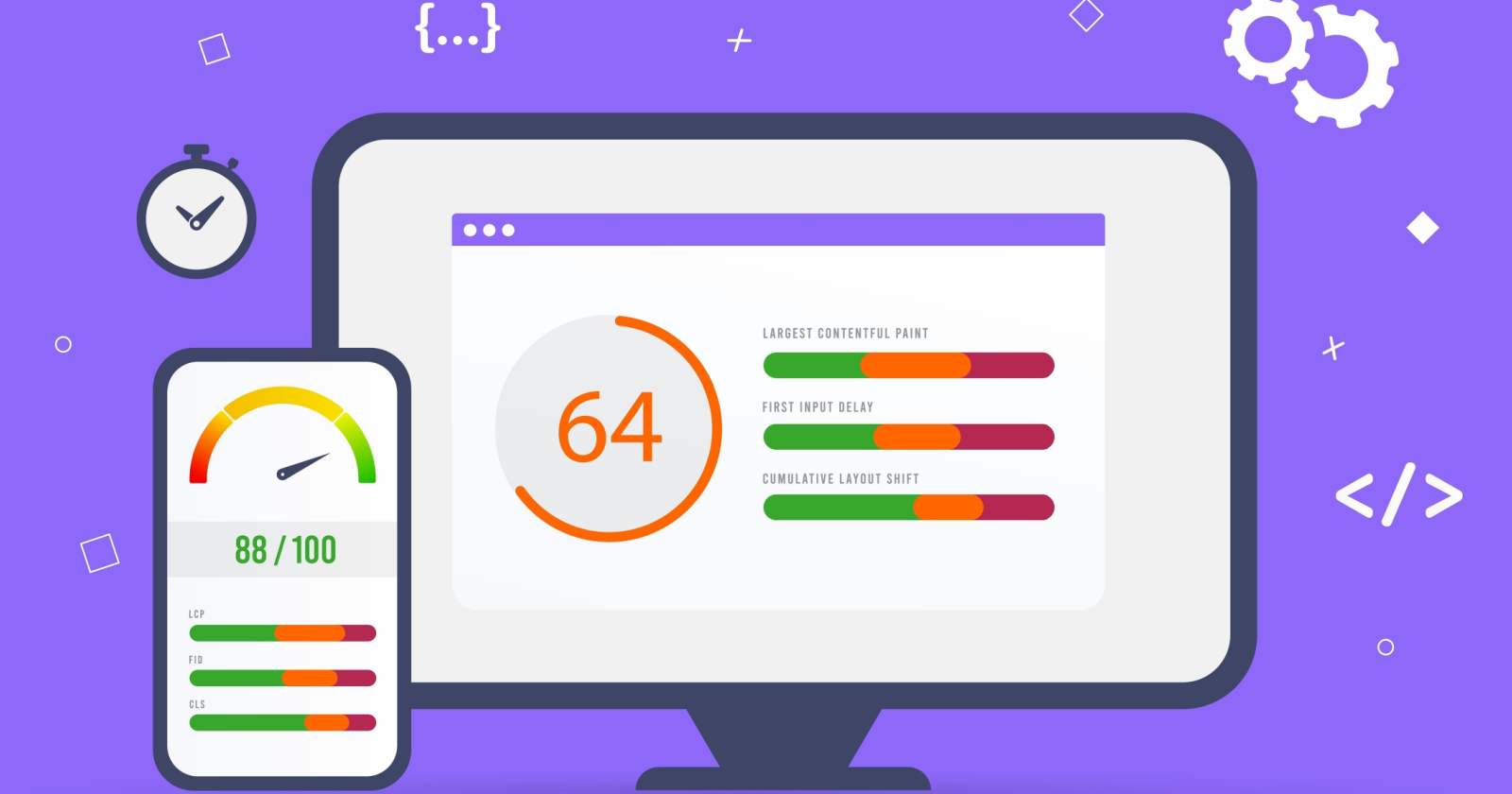
Google is set to introduce Interaction to Next Paint (INP) issue reporting as a part of its Core Web Vitals report in Search Console.
This development is a proactive step towards Google’s strategic change slated for March 2024, which will see the retirement of the First Input Delay (FID) metric and its substitution with INP.
Until the transition, INP will remain a pending metric, but early optimization could be the key to a seamless transition.
Google announced the update to Search Console on Twitter.
Deep-Diving Into The Impending Changes
The new INP data will be visible in the Search Console reports aiding website owners in preparing for the update next year.
The Core Web Vitals report is a robust tool designed to give insights into webpage performance, reflecting the actual user experience on your site.
It classifies URL performance into three broad categories: “Good,” “Needs Improvement,” and “Poor,” offering a simple but effective way to evaluate user experience.
Contrary to FID, which measured only delay, INP takes a holistic approach to gauging the overall responsiveness of a page.
A poor INP score could imply that an expected action, such as an image closeup, takes too long after user interaction.
A good INP score, on the other hand, signifies quick visual feedback after an interaction, assuring the user that their input is being processed.
Ideal INP scores fall under 200ms, while scores ranging from 200-500ms indicate room for improvement, and anything over 500ms is deemed poor.
Optimization for INP involves reducing delays associated with loading scripts, fetching resources, and parsing HTML/CSS to display a page correctly.
In the case of complex interactions, the key is providing initial visual feedback.
Websites optimized for speed and performance should see good INP scores immediately. However, websites that haven’t been actively monitoring these metrics may encounter problems and potentially see a drop in rankings once the change is implemented.
Looking Ahead
Google’s introduction of INP issue reporting in Search Console is designed to facilitate a smooth transition for its users.
By giving website owners ample time and the necessary tools, Google ensures you have everything you need to optimize your webpages before the March 2024 deadline.
With the right approach, INP optimization and a speedy and engaging user experience are achievable for any website.
Featured Image: BestForBest/Shutterstock
SEO
CMOs Called Out For Reliance On AI Content For SEO

Eli Schwartz, Author of Product-Led SEO, started a discussion on LinkedIn about there being too many CMOs (Chief Marketing Officers) who believe that AI written content is an SEO strategy. He predicted that there will be reckoning on the way after their strategies end in failure.
This is what Eli had to say:
“Too many CMOs think that AI-written content is an SEO strategy that will replace actual SEO.
This mistake is going to lead to an explosion in demand for SEO strategists to help them fix their traffic when they find out they might have been wrong.”
Everyone in the discussion, which received 54 comments, strongly agreed with Eli, except for one guy.
What Is Google’s Policy On AI Generated Content?
Google’s policy hasn’t changed although they did update their guidance and spam policies on March 5, 2024 at the same time as the rollout of the March 2024 Core Algorithm Update. Many publishers who used AI to create content subsequently reported losing rankings.
Yet it’s not said that using AI is enough to merit poor rankings, it’s content that is created for ranking purposes.
Google wrote these guidelines specifically for autogenerated content, including AI generated content (Wayback machine copy dated March 6, 2024)
“Our long-standing spam policy has been that use of automation, including generative AI, is spam if the primary purpose is manipulating ranking in Search results. The updated policy is in the same spirit of our previous policy and based on the same principle. It’s been expanded to account for more sophisticated scaled content creation methods where it isn’t always clear whether low quality content was created purely through automation.
Our new policy is meant to help people focus more clearly on the idea that producing content at scale is abusive if done for the purpose of manipulating search rankings and that this applies whether automation or humans are involved.”
Many in Eli’s discussion were in agreement that reliance on AI by some organizations may come to haunt them, except for that one guy in the discussion
Read the discussion on LinkedIn:
Too many CMOs think that AI-written content is an SEO strategy that will replace actual SEO
Featured Image by Shutterstock/Cast Of Thousands
SEO
Here’s How You Can Outsource SEO Easily and Effectively (+ Best Practices)
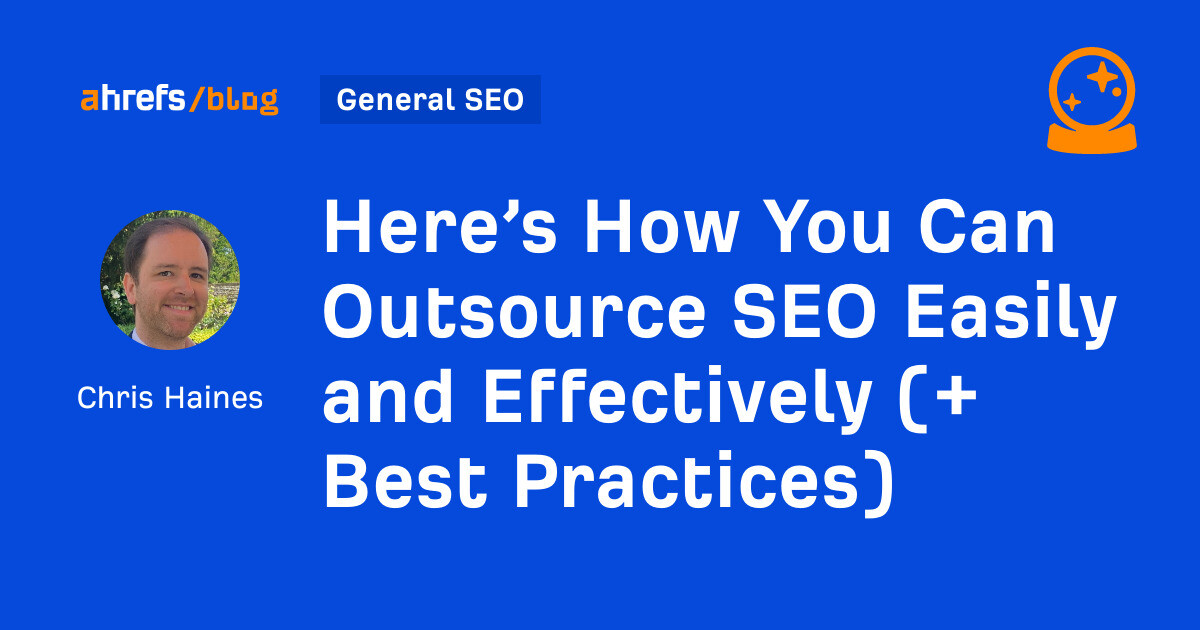
Struggling to find time for essential SEO tasks? Outsourcing SEO might be the solution.
Outsourcing SEO allows you to leverage expert knowledge and free up time for other critical aspects of your business.
To outsource effectively, you’ll need to hire an SEO freelancer or an SEO agency and decide what parts of your SEO campaign you want to delegate.
In this beginner’s guide, I’ll explain what SEO outsourcing is, share services often outsourced, and discuss best practices based on my agency experience.
I’m guessing you clicked on this post to see if outsourcing SEO is right for your business. But what is it exactly?
SEO outsourcing involves hiring an external agency or freelancers to handle SEO tasks. Whether you need a freelancer for keyword research or a full-service agency to handle every aspect of SEO, outsourcing can be tailored to your specific needs.
For example, it could look like this—with a single SEO freelancer supporting your company.
But, if your business needs more support, a lone freelancer may not be enough, and you may need to outsource SEO to a dedicated agency, which might look like this.
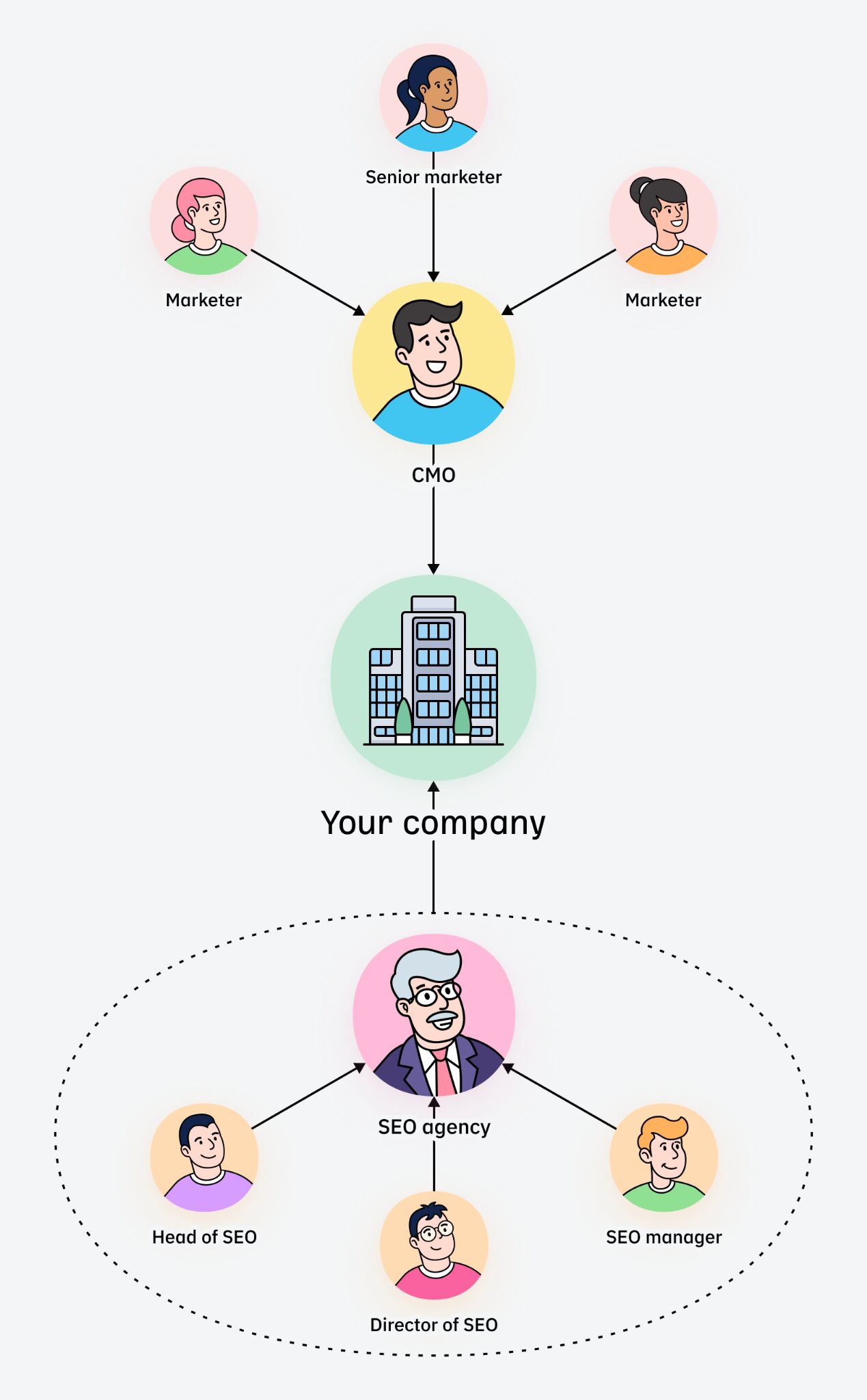

And sometimes, a company may outsource parts of its SEO campaign to a mix of freelancers and agencies, as illustrated below.


The reality is outsourcing SEO takes different forms and depends on your business needs.
So, when should you consider outsourcing SEO? There are two main reasons:
- The first is urgency – If you need a project delivered within a short timeframe, outsourcing SEO is usually the best option because hiring a full-time employee takes time to hire and train them
- The second is budget – Outsourcing SEO is usually more cost-effective than hiring a full-time employee because you can hire freelancers for specific tasks and not have to pay benefits or salary
There are also more specific reasons where SEO outsourcing can be beneficial.
For instance, if you:
- Need very specific SEO expertise – e.g., Law firm SEO, plumbing SEO, dental SEO, etc.
- Need to reduce the workload for in-house teams quickly
- Need speed and efficiency of delivery
- Have a new client but don’t have time to hire an FTE
- Want a hands-off approach to SEO
- Want to focus on an area of SEO you’re good at rather than something you’re not
If these feel like familiar challenges, it’s worth considering outsourcing SEO.
If you want to outsource your entire SEO strategy and don’t have much knowledge of SEO yourself, then an agency is probably the best option (assuming you’re willing to pay $1001+ per month.)
Here’s why.
- You get access to an account manager and a team of SEO experts
- You also get access to the best tools in the business – Although agency fees are typically higher than a freelancer’s, agencies often have access to many different tools, some of which could be unaffordable for either your company or a freelancer
- You get expertise – Agency SEOs don’t just work on one client. They work on many different client accounts spanning many different industries – they bring this expertise to the table in every meeting
However, if you’re looking to outsource a specific part of your SEO strategy, such as content, keyword research, or link building, and you’re working on a tight budget, then it could be better to start talking to a freelancer.
- Freelancers are usually more cost-effective – They usually have fewer overheads than agencies. According to Josh’s SEO pricing study, SEO agencies charge 138% more than freelancers
- Freelancers are often faster to work with – Due to less paperwork and onboarding processes
Both agencies and freelancers can meet your SEO needs, but your choice depends on your desired level of involvement and budget.
To summarize, SEO agencies are ideal for businesses with a hands-off approach or a larger budget. Freelancers are best for accessing specialized knowledge within a tighter budget.
Outsourcing allows you to delegate time-consuming or complex SEO tasks without overburdening your team.
Here are some key services you can outsource in SEO.
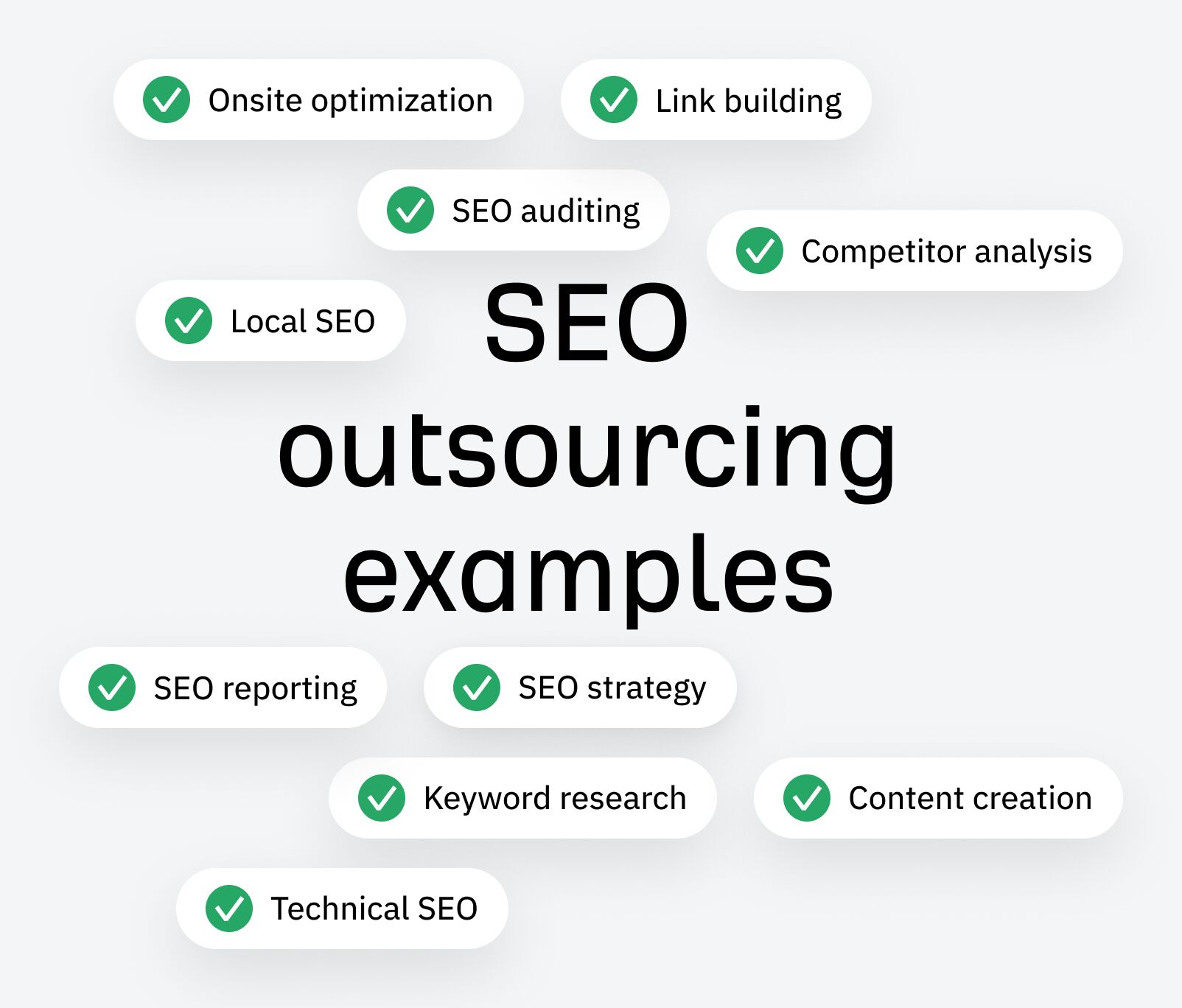

As there are at least 67 types of SEO, I can’t cover every service here, but you get the idea—almost everything in SEO can be outsourced for a price.
Here are the most common outsourced SEO services based on my previous agency experience.
Content creation
Sometimes content creation can become overwhelming, and you may need extra support. Outsourcing parts of your content creation can help ease the workload.
So, what do you need to know when outsourcing content? These are the most important considerations:
- What it costs to outsource content
- What to look for when outsourcing content
- What risks are there with outsourcing content
Cost
The cost of outsourcing content can vary a lot. You can pay as little as a few dollars or thousands of dollars per article. It depends on your budget.
Ahrefs’ study into cheap vs expensive freelance writers revealed that the median cost of a writer was ~$0.15 per word. It may be more or less depending on what region you’re in, but this gives you a benchmark of what you can expect to pay for content.
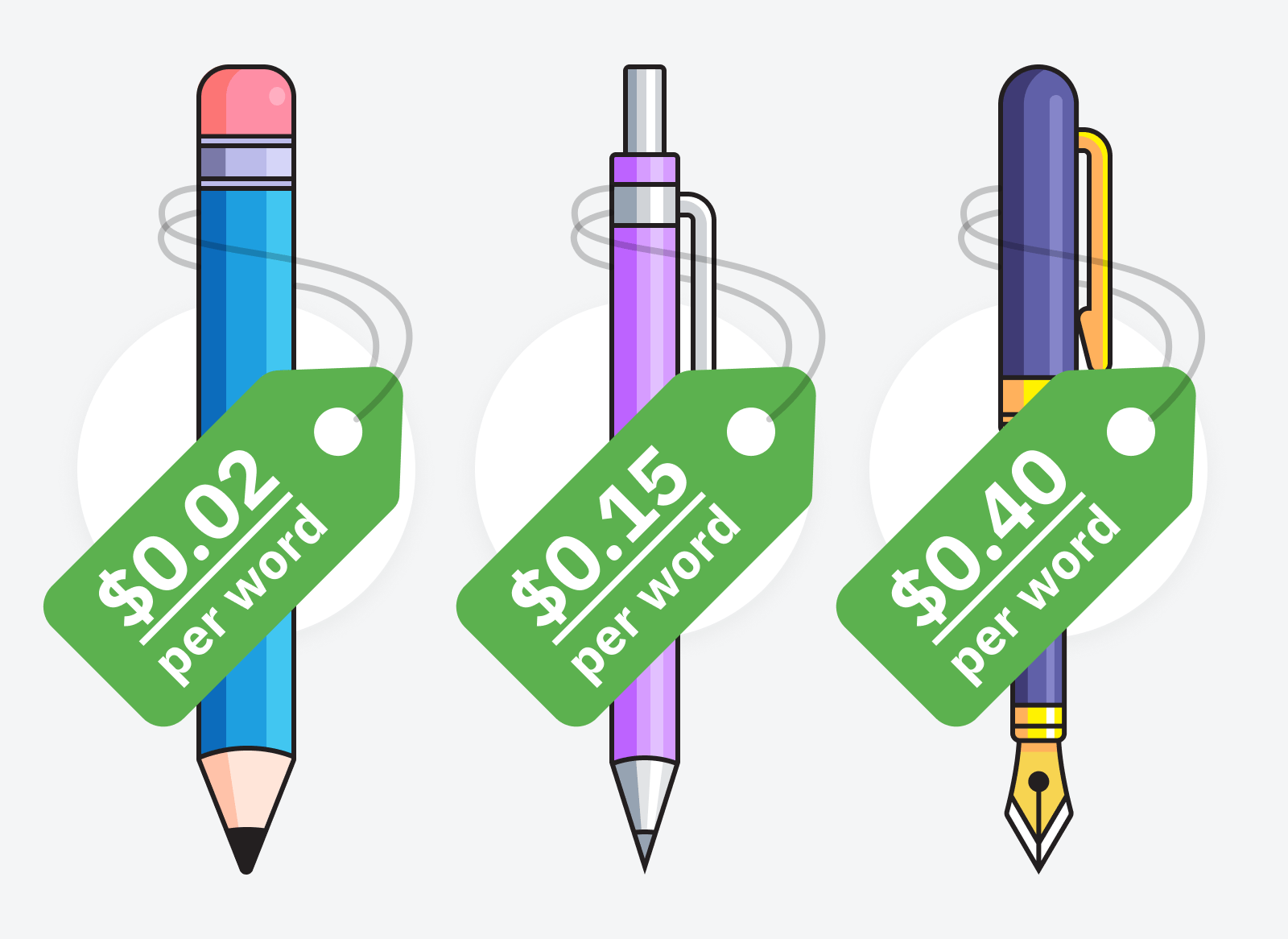

In my experience, I’ve never hired a writer for as cheap as $0.02 per word. I usually pay ~$0.20 upwards for content. The reason: I’ve learned through experience that very cheap content, although tempting, often requires a lot of editing.
This, in my opinion, defeats the purpose of outsourcing SEO in the first place—as you either have to edit yourself or hire an editor. Sometimes, it’s just better to get a decent writer the first time around.
What to look for
Here are the key things I looked for when hiring content writers at my previous SEO agency:
- Understands the content brief and requires minimal “hand holding”
- Native-language speaker
- Proven experience in writing about the topic
- Responsive to feedback
Potential risks
There are three key risks of outsourcing content:
- AI or automation – The cheaper your content writer is, the higher the chances they may be using automation or AI to create the content. Ask your writers how they create their content. Using AI doesn’t mean your content won’t rank in Google, but it is something to be aware of because your writer may not have even reviewed the content themselves
- Yawn-inducing content that sends your readers into a coma – Freelance writers are less invested in your brand, so they may not convey much personality in their writing. Counteract this by creating detailed briefs instructing the writer on your brand’s tone of voice
- Over-optimized SEO content – Sometimes, writers go overboard mentioning specific keywords or having an H2 heading every three sentences: “FoR tHe SeO.” Counteract this by instructing them what the headings should be and how they should mention keywords
Finding content creators
Need a reliable content writer? Here’s where I usually start looking.
If you need a longer-term commitment on a bigger scale, working with a content agency might be a better option.
Tip
Keep a spreadsheet of your favorite freelance writers and agencies, including their rates, your review, and their specialization.


Link building
Like content, link building is often outsourced for the same reason—it’s time-consuming.
So, what do you need to know when outsourcing link building? These are the most important considerations:
- What it costs to outsource link building
- What to look for when outsourcing link building
- What risks are there with outsourcing link building
Cost
Sure, you can buy links from Fiverr for five bucks, but these links won’t help you rank in Google for long—or at all.
So, what’s the average cost of link building? Well, it depends…
For example, it depends on your location:
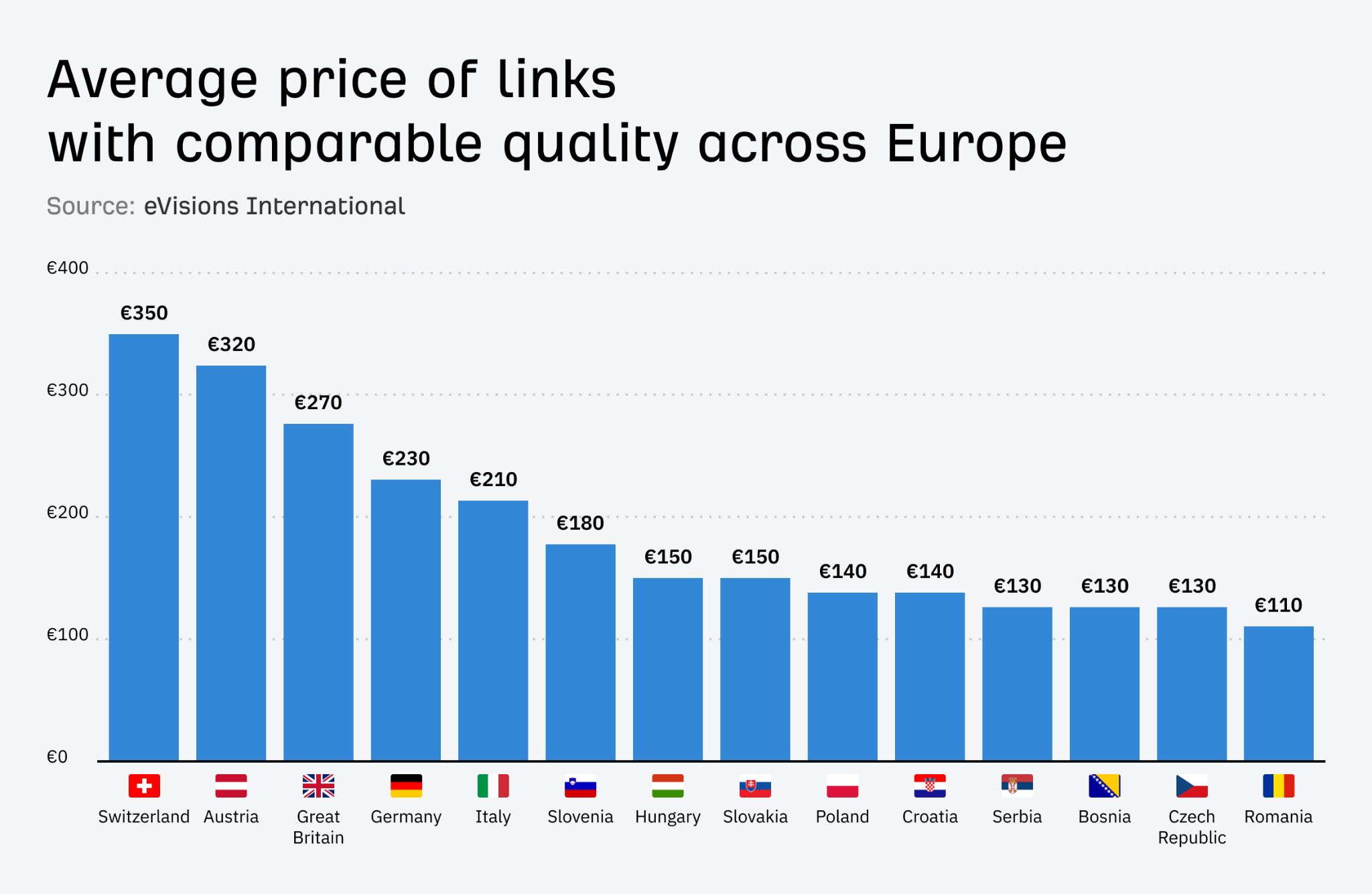

And the type of link building you’re doing.


Sidenote.
Before we proceed, it’s worth noting that Google considers buying links for ranking purposes a link spam technique — so take my advice here at your own risk.
What to look for
Here are the key things I looked for when hiring link builders at my previous SEO agency:
- Can build high-quality links that help improve rankings
- Has a reputation for ranking websites in the industry I was looking for
- Understands what a high-quality backlink looks like
- Creates the links themselves in-house
Potential risks
The number one risk of outsourcing link building is getting low-quality links. So, how can you avoid this?
Here’s what I check:
- Is the site a legitimate website? Does it look like a website you would trust?
- Is the site getting actual organic traffic? Check the Overview report in Site Explorer
- Do the Ahrefs metrics align with other sites of a similar authority? Check anchor text, and referring domains
- Does the website look like it’s selling links? Look for anchor text with high commercial intent that looks suspicious, like the below example
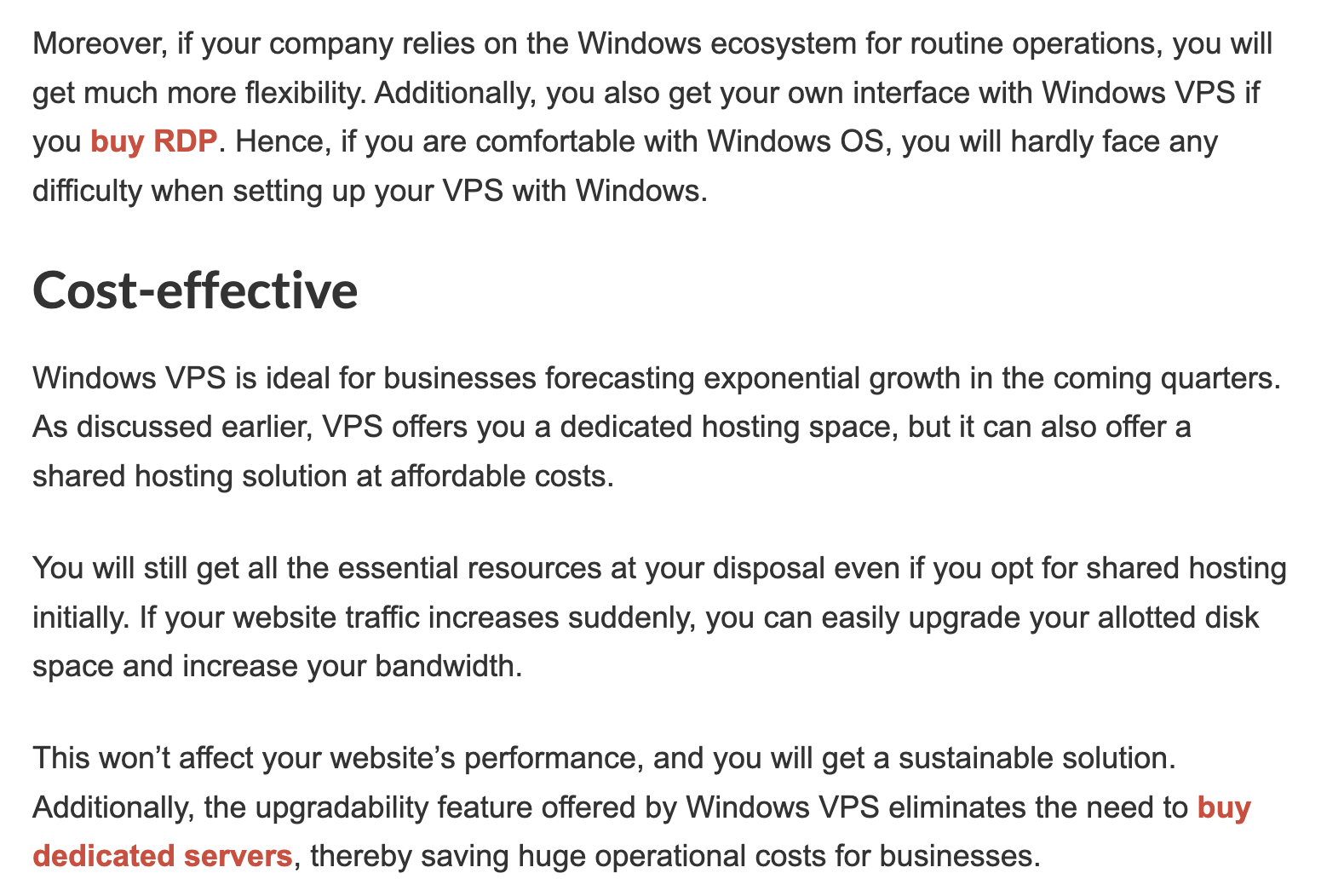

In the image above, there are two examples of commercial anchor text in red that look unnatural.
Finding link builders
My go-to place for finding link builders is freelance platforms like Upwork.
If you need to scale faster, an agency might be a better option. There’s no shortage of link-building agencies out there, and for a fee, they will help you get links for your website.
Technical SEO
When your site has a serious technical issue and performance has dropped, you may need to hire a technical SEO. The first indicator that something could be wrong is if you notice a significant drop in the health score of a tool like Ahrefs’ Site Audit.
That may look something like this.


If this is combined with a drop in organic traffic on Site Explorer’s Overview, you may need to find a technical SEO freelancer—fast.
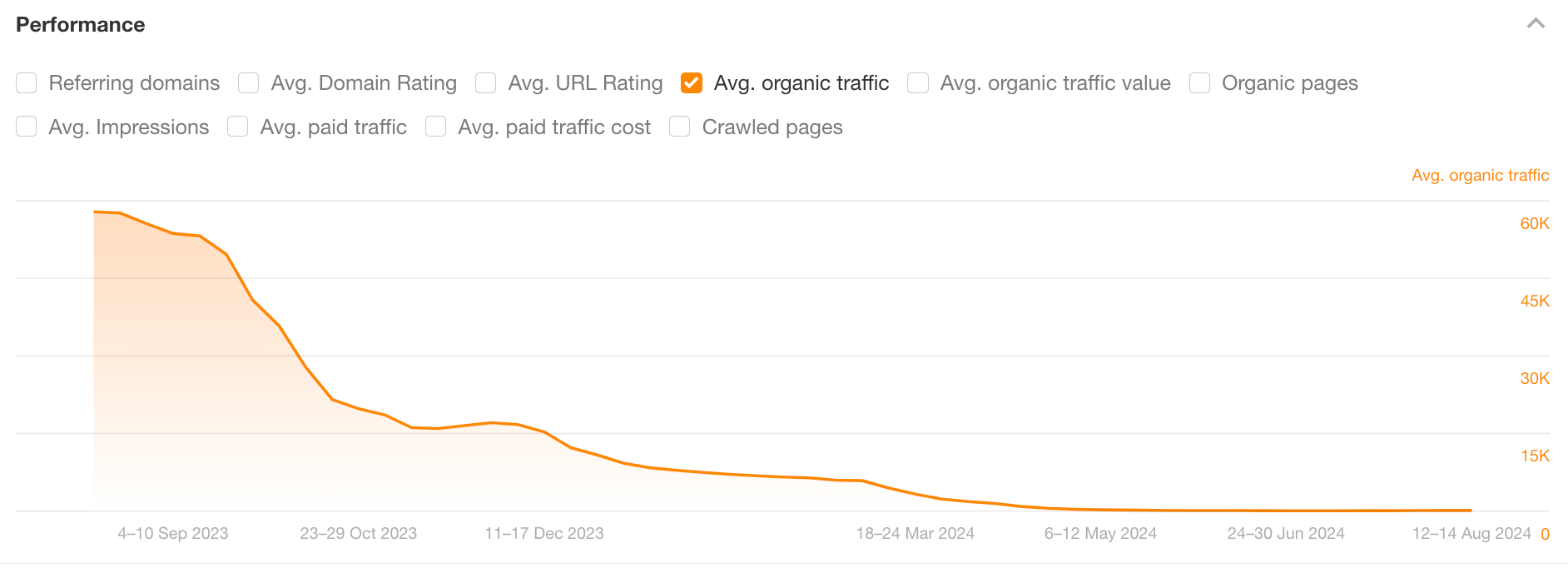

Cost
Technical SEO varies in complexity and cost, making it crucial to choose an experienced partner who can quickly address issues to prevent sustained traffic loss. After looking at Upwork, you can get a freelancer for as little as $8 to $200 an hour.


It’s a huge variation, so to avoid disappointment I normally stay clear of the lower end of pricing.
What to look for
Look for someone with:
- Significant proven experience in technical SEO — Check to see what level of experience they have
- Knowledgeable about your area of search — Check to see if they’ve worked on similar websites before
Potential risks
Unfortunately, like links and content, there are also risks associated with outsourcing technical SEO.
So what are they?
- Bad advice – Incorrect advice could lead to more problems
- Wrong prioritization – The wrong issues may be prioritized, leading to prolonged loss of organic traffic
- Communication breakdown – If a technical SEO leaves mid-project, it could cause further ongoing issues
Finding technical SEOs
Look through LinkedIn and message technical SEOs for advice. One of the big advantages of using LinkedIn is that it’s free to message people.
For example, here’s a snapshot of a LinkedIn profile from one of my former colleagues. You can see this person has solid technical SEO experience. This is what a good profile looks like—but it will cost you.


With an SEO of this caliber, you only need to spend a few hours consulting with them to work out your technical SEO issues. However, if you continuously spend money at the lower end of the spectrum, you may never get your technical SEO issues resolved.
Keyword research
If you want to rank on Google, you can try guessing what keywords will bring you traffic. Or you can reverse engineer what is already working in Google using data from tools like Ahrefs Keywords Explorer.
For one or two keywords, you can research using our free keyword generator. But if you need a lot of keyword research, for instance, for a new website, then it could be a good idea to outsource it.
Cost
Keyword research on Upwork starts at ~$50, cheaper than most other SEO services mentioned here. But like many of the other SEO services mentioned here, there is good keyword research and bad keyword research.
What to look for
- They use a trusted keyword research tool like Ahrefs’ Keywords Explorer
- They go beyond just search volume and the keywords and look at metrics like Traffic potential and Keyword Difficulty
Potential risks
Here are the risks of outsourcing keyword research based on my experience:
- Targeting the wrong keywords – Sometimes, after you’ve written an article, you’ll find that it doesn’t get much traffic. Often, the reason is the article that you’ve written doesn’t completely fulfill the search intent for that precise keyword
- Data is inaccurate due to using a low-quality SEO tool
- Data is too simplistic – e.g., only keywords and search volume. In my experience, I would expect metrics like Keyword Difficulty and Traffic Potential to be included as well to help make an informed decision of whether the keyword was worth targeting
Finding keyword research experts
Keyword research is usually provided as a standard part of an agency’s SEO services, but if you’re not with an agency, you can either hire a freelancer to do it or do your research using a tool like Ahrefs’ Keywords Explorer.
Over the years, I’ve spent a small fortune on freelancers. Some have been incredible, and some have been incredibly bad. Avoid the bad ones by following my hard-earned best practices.
Request these things when working with outsource partners
I’ve worked with many outsourcing partners in my agency career, from freelancers to external agencies. If I want to work with them, I always request three things:
- An SEO proposal for the work. Ask for an SEO proposal of what they are going to do, check out my article on SEO proposals to get a rough idea of what one should look like
- References from their recent work. Ask for references. Don’t have any? That’s an instant red flag. This is less about the references themselves and more about seeing how fast a potential outsource partner can share a glowing reference. Look for someone who has a good track record in your industry or particular niche
- A video call interview. If they’ve passed the first two tests, it’s time for a quick 30-minute interview. Again, this is less about talking about what they’ve achieved but rather about seeing whether you could work with this person or group regularly
Use a Kanban board to track progress toward your goals
Kanban boards are the perfect way to track tasks when outsourcing SEO, but many people overcomplicate them.
When I worked in an agency, I had a simple setup like the one below.


I ran and managed a ~$50k pm enterprise SEO account, several external agencies, and a development team using this exact Kanban board format.
The lesson here: don’t overcomplicate things. You can use many tools, but my favorites are Notion and Trello.
Tip
Combine a Kanban board with a tool like Slack to quickly resolve queries from external agencies and freelancers.
Create standard operating procedures (SOPs)
Without clear SOPs, work can be easily misinterpreted, leading to last-minute revisions. Define tasks clearly from the start to ensure desired outcomes.
Create SOPs to define exactly what you want delivered. Otherwise, you will not get the desired output.
For basic tasks, you can create a basic SOP for free using a tool like Google Docs, Trello, or Notion. You can even use ChatGPT to create one.
Here’s an example of a prompt I used to create an SOP for Keyword Research using Ahrefs.


Or, for more complicated tasks that involve multiple tools, techniques, or processes, use a tool like Scribehow—it’s useful for quickly building more detailed SOPs that involve multiple tools or processes.
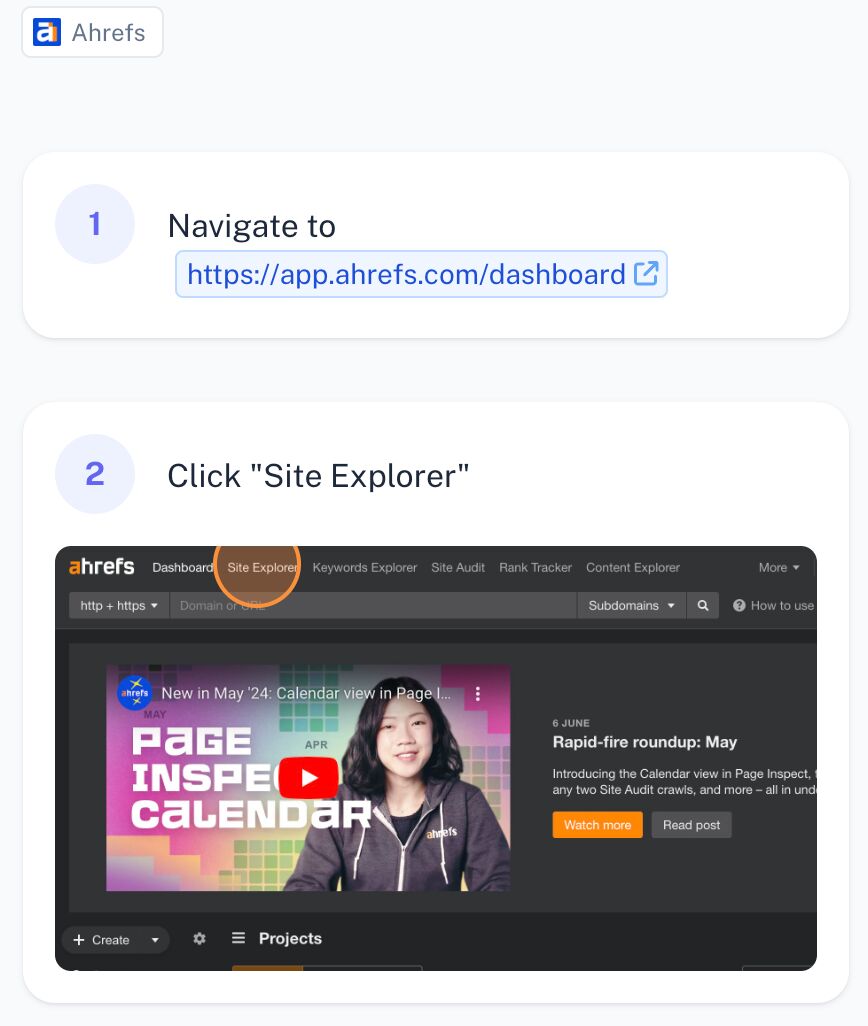

Set clear goals and monitor progress using Ahrefs
Once you’ve hired your outsource partner, you should establish clear delivery deadlines and schedule regular check-ins to ensure your delivery date is achievable.
But if you do not know SEO, how can you ensure the job has been completed well? You can use tools like Ahrefs to check.
Use Site Explorer’s Overview to check organic traffic and links and correlate the impact of content changes.
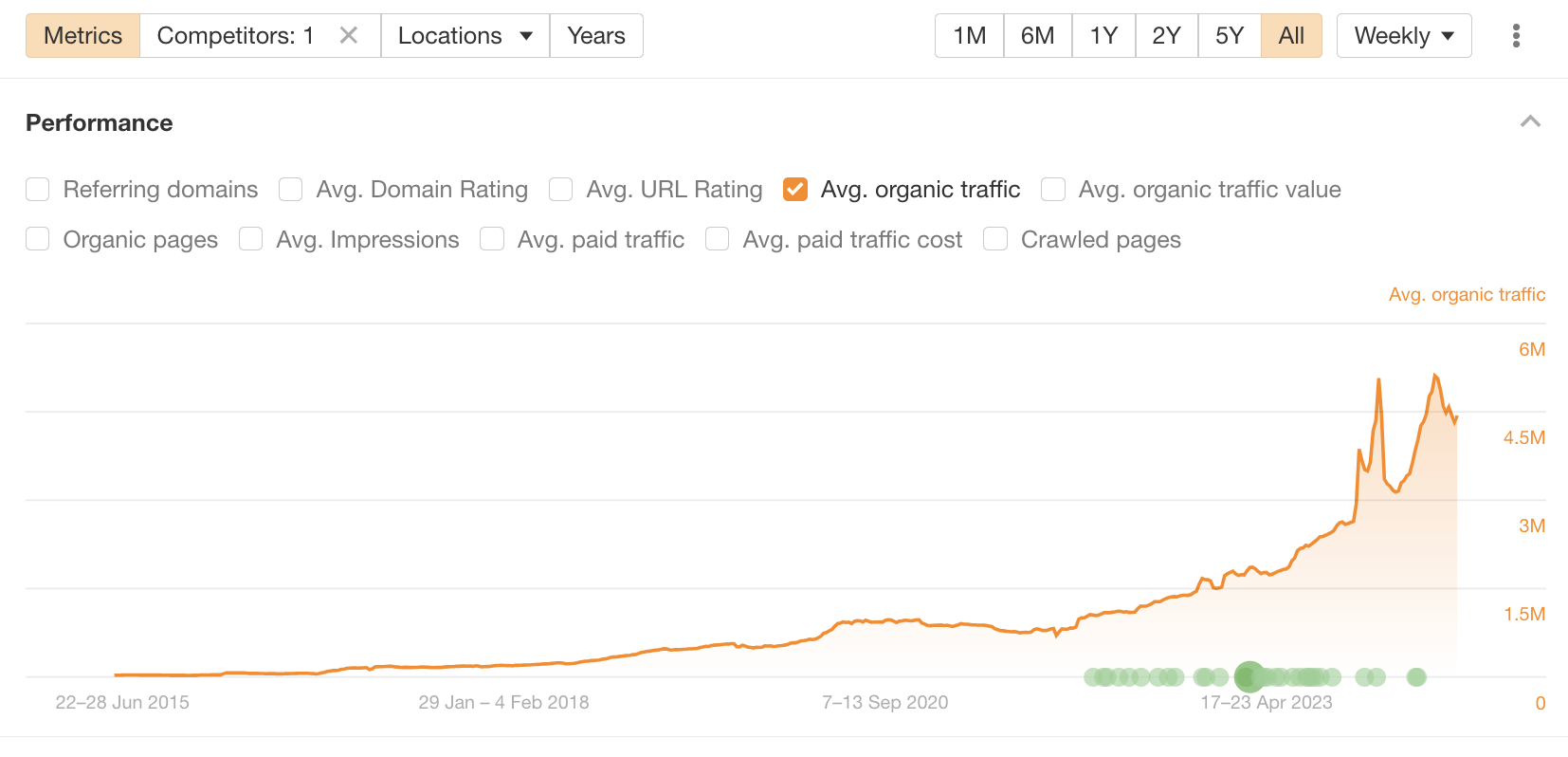

Use Site Audit to check technical SEO performance.
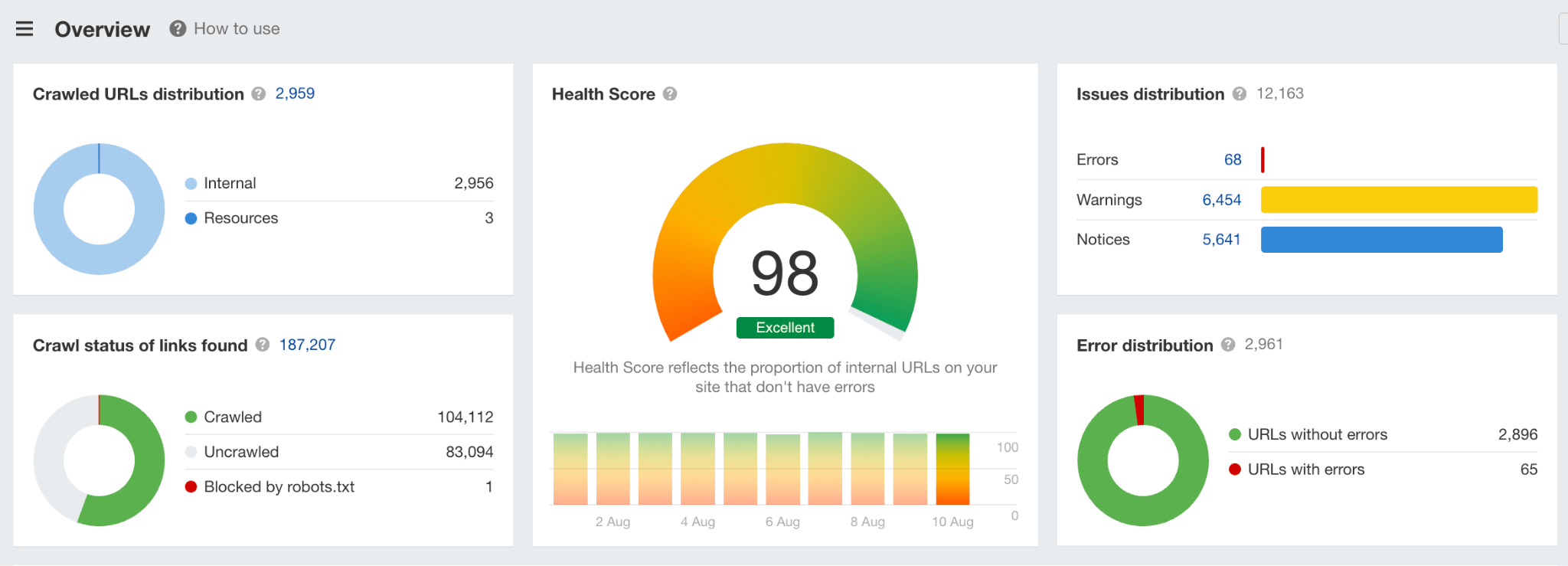

Use Keywords Explorer to double-check keyword research.


Use Rank Tracker to monitor important keyword rankings over time.
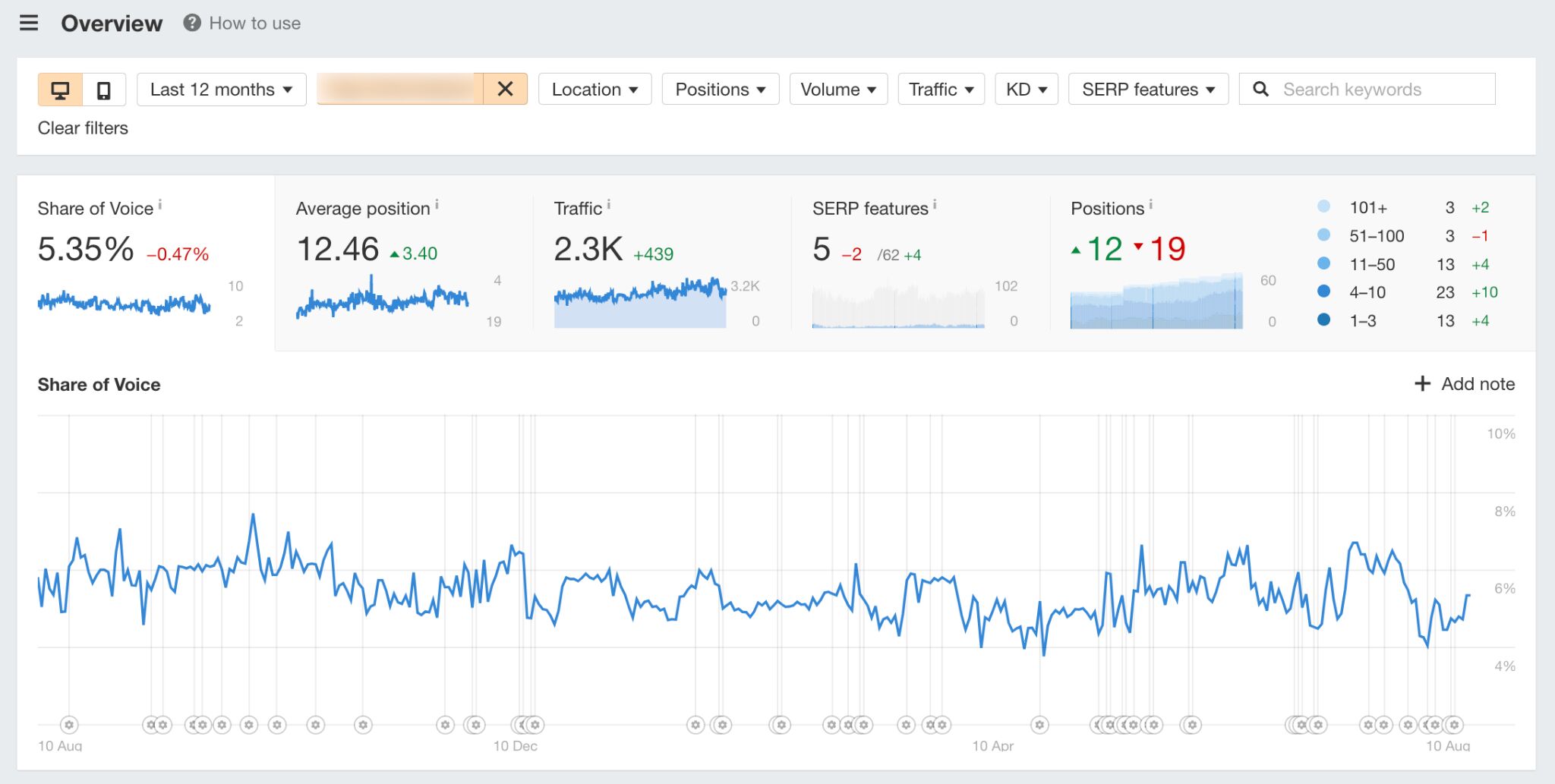

If you have a copy of Ahrefs, you can monitor almost every aspect of what your outsource partner is doing. So, even if you aren’t doing SEO yourself but want to keep track of progress, it’s a useful tool.
Final thoughts
If you want to outsource SEO, there’s no shortage of people to fill the role, but finding your perfect outsourcing partner(s) is usually the biggest challenge.
To get the right partner, vet thoroughly, create SOPs, and set clear expectations and goals, and you won’t go far wrong. If you are unsure of the quality of the work delivered, you can double-check using tools like Ahrefs to monitor their progress.
Got questions? Let me know on LinkedIn.
SEO
I Disavowed “Toxic Backlinks”: Here’s What Happened

On July 26th 2024, I exported all “toxic” and “potentially toxic” backlinks to three of our blog posts from a well-known SEO tool. There were 129 URLs in total, which I disavowed in Google Search Console.
After disavowing, traffic (as reported by GSC) fell by 7.1%:


Sidenote.
Google began rolling out a Core Update on August 15th, which is why I cut the experiment short to only 20 days. My plan was to leave it running for a full month, but I think just shy of three weeks is enough time to see results anyway.
Before disavowing, according to GSC, traffic to these posts was trending slightly upward:
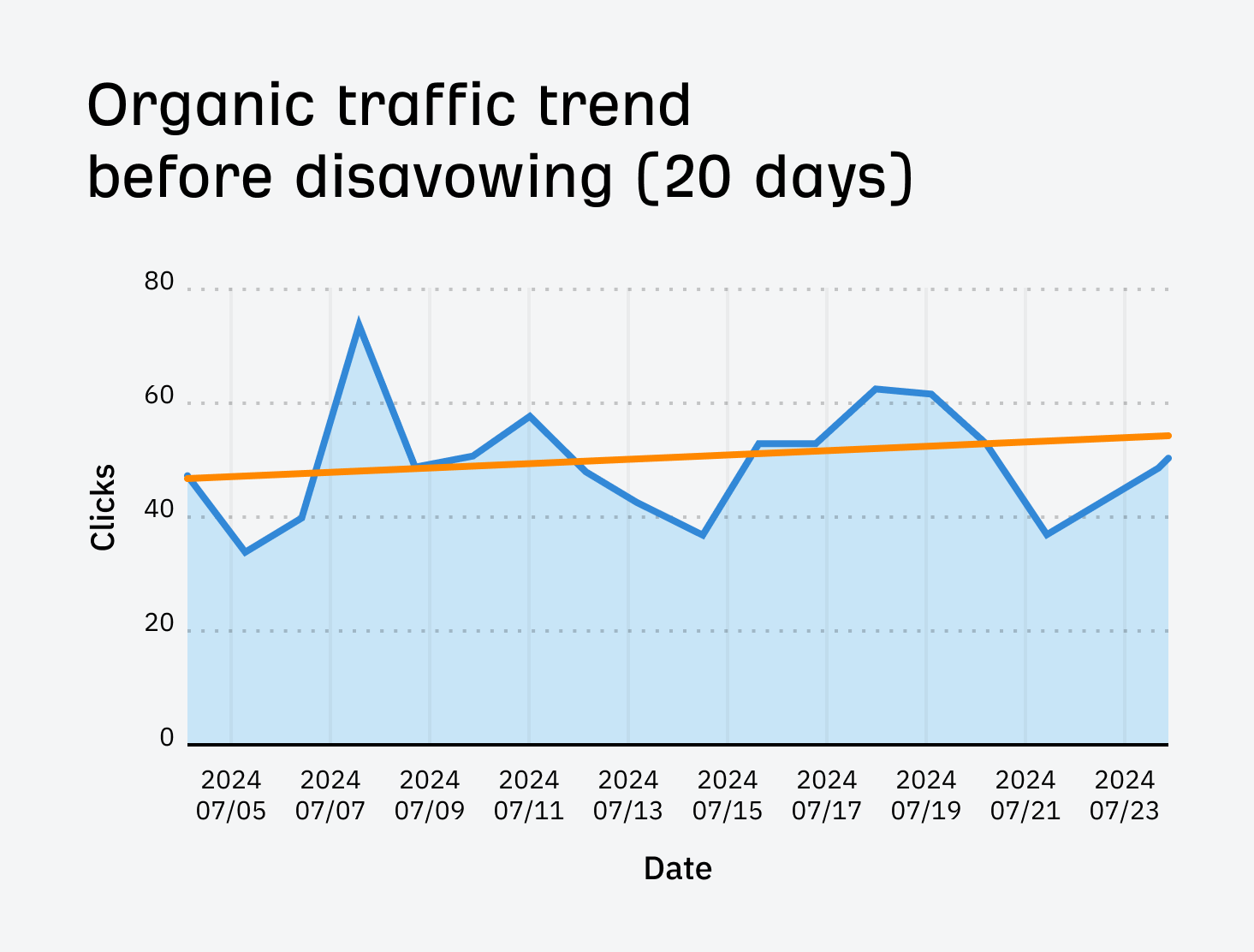

After disavowing? Slightly downward:
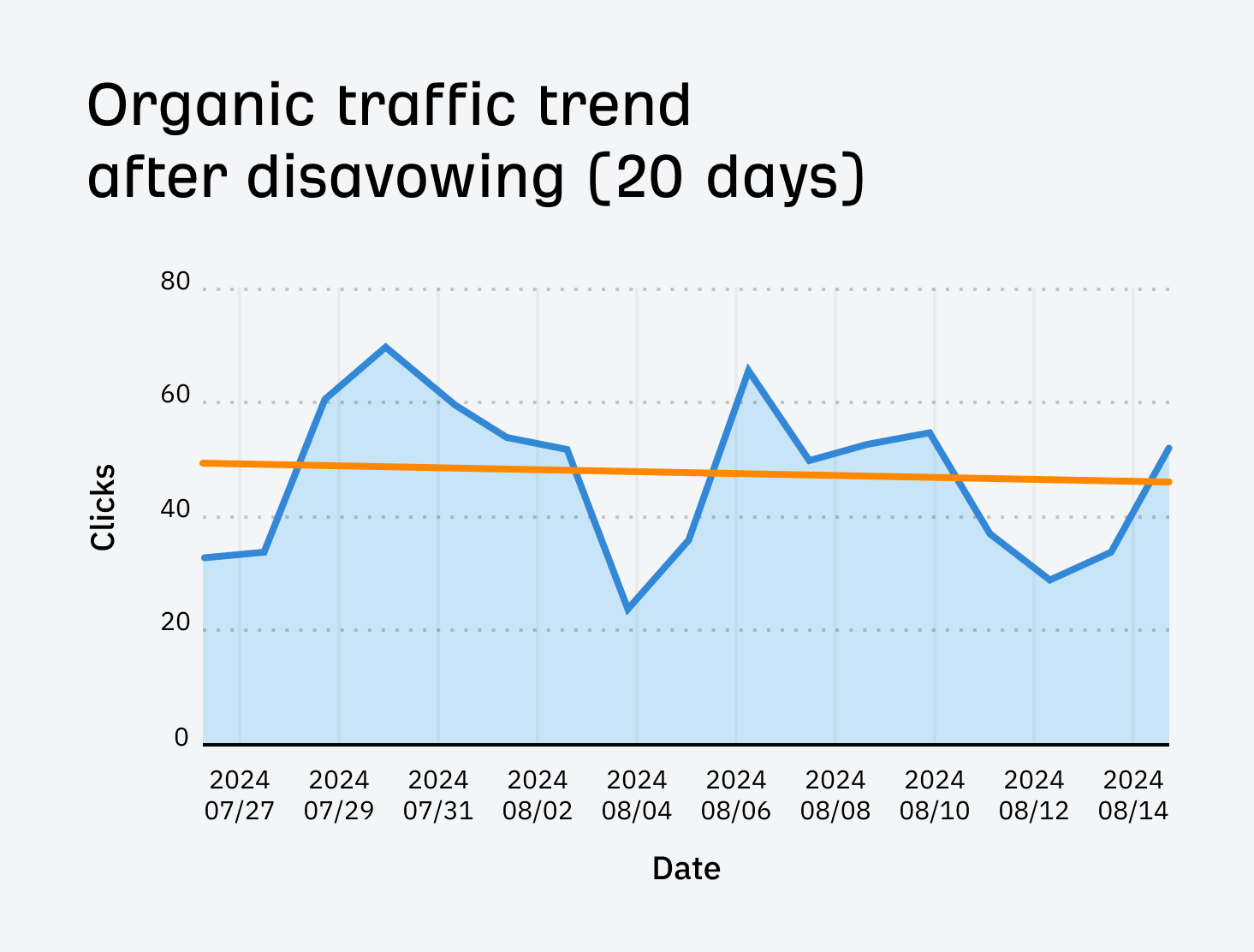

However, Ahrefs’ organic traffic estimates tell a slightly different story. Visibility is trending slightly downward before disavowing…
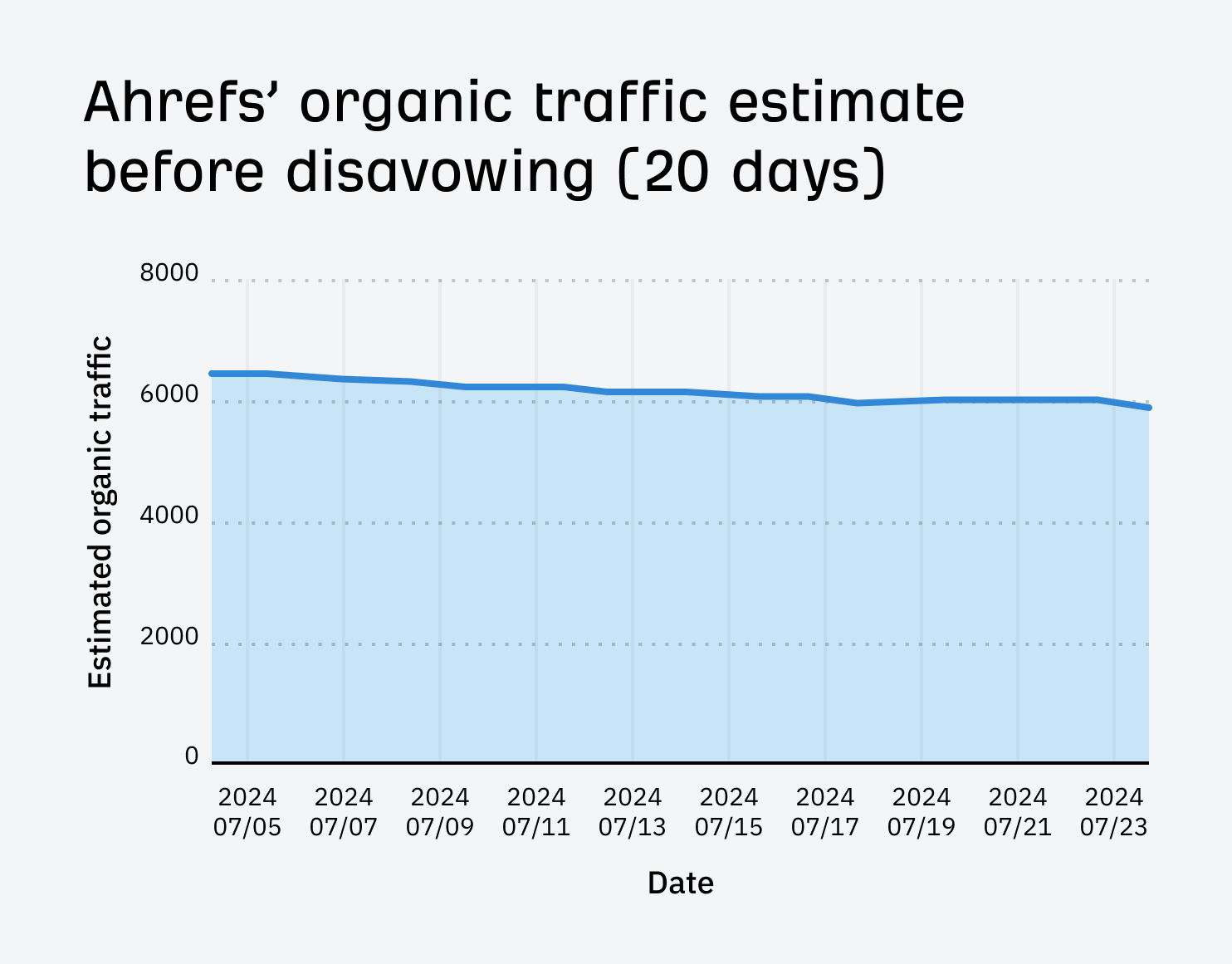

… and after disavowing:


I asked Patrick Stox how he’d interpret this. Here’s what he said:
I would personally look at Ahrefs data here. Average search volume in Ahrefs will show if it impacted rankings and visibility, although our data may be slower to update than GSC. GSC can have seasonality, luck, etc. involved, so it’s not as consistent of a measure.
Makes sense. In this case, it looks like disavowing had little to no impact on rankings/visibility overall. But let’s take a closer look at the data…
Test pages
The data above is for all three pages combined, so let’s take a look at what happened to each page individually.
This page was our SEO pricing guide.
For the 20-day period before the disavow, the post got 574 organic visits. This fell by 12% to 505 visits in the following 20 days (when the disavow was in place).


Before disavowing, organic traffic to this post was flatlining:


After disavowing, it’s still flatlining:
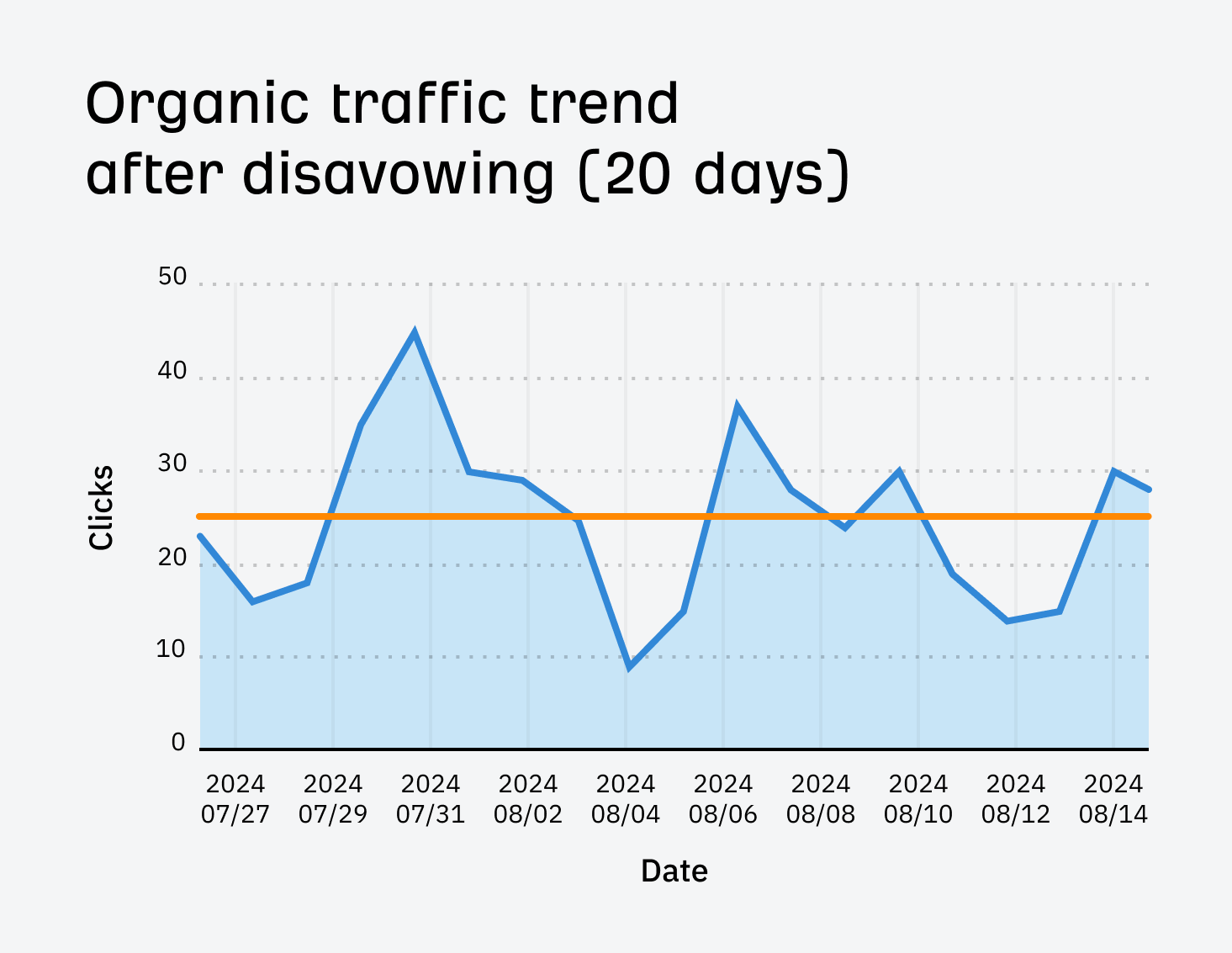

Ahrefs data tells a slightly different story…
Before disavowing, estimated organic traffic was trending slightly downward:
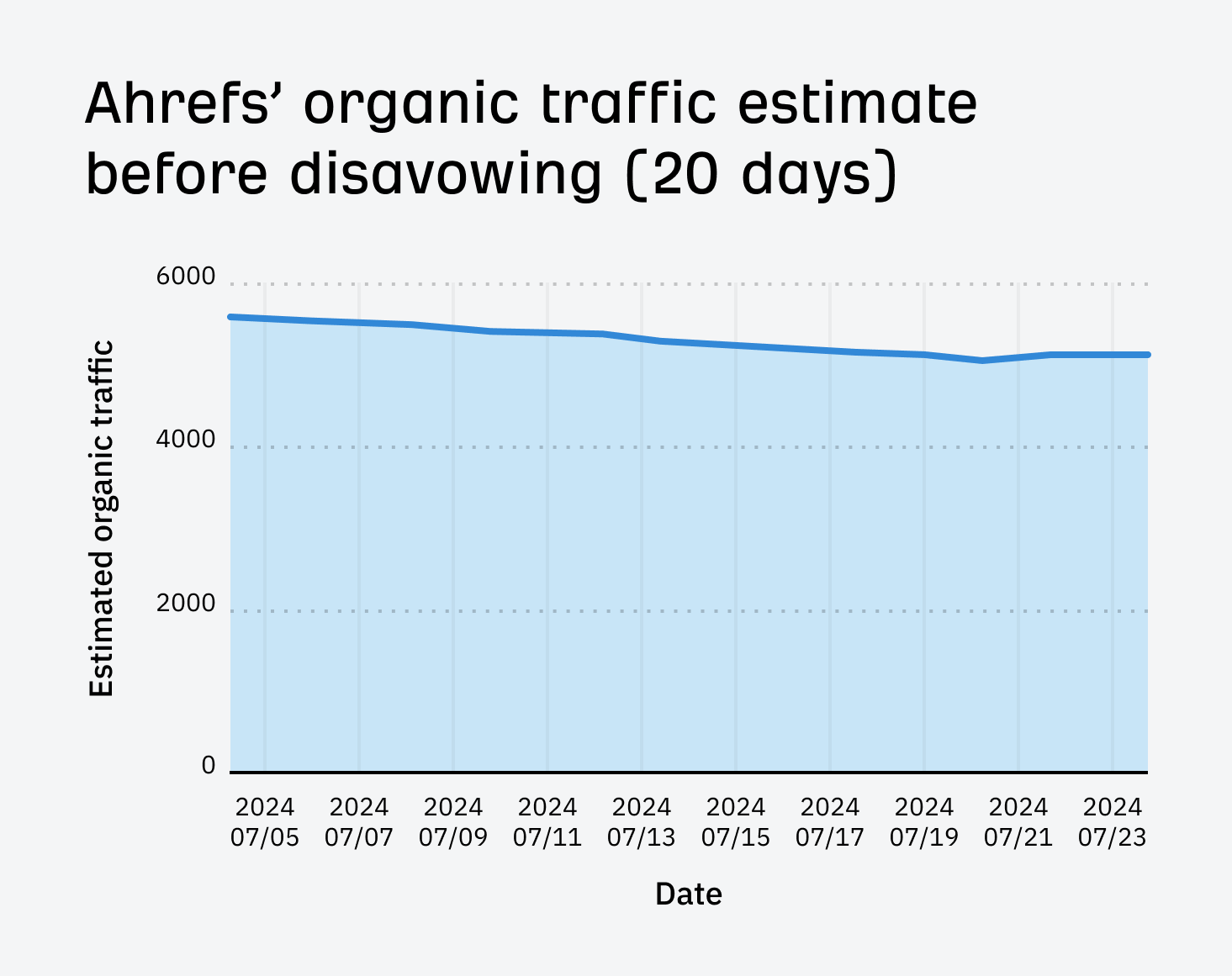

After disavowing, it’s flatlining:
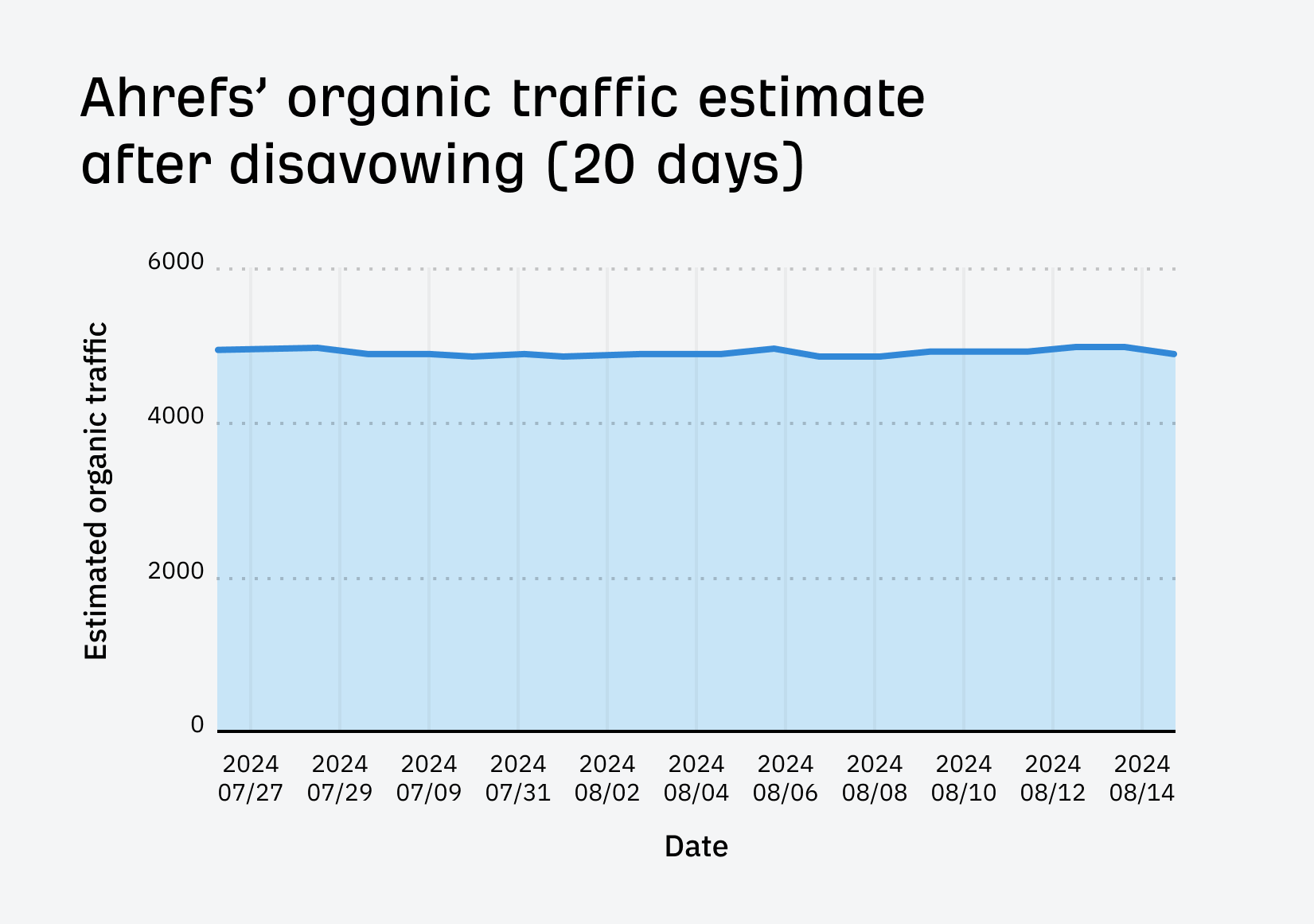

Long story short? Disavowing might have had a small positive impact, but I believe it’s more likely that a long downward trend is just finally leveling off.
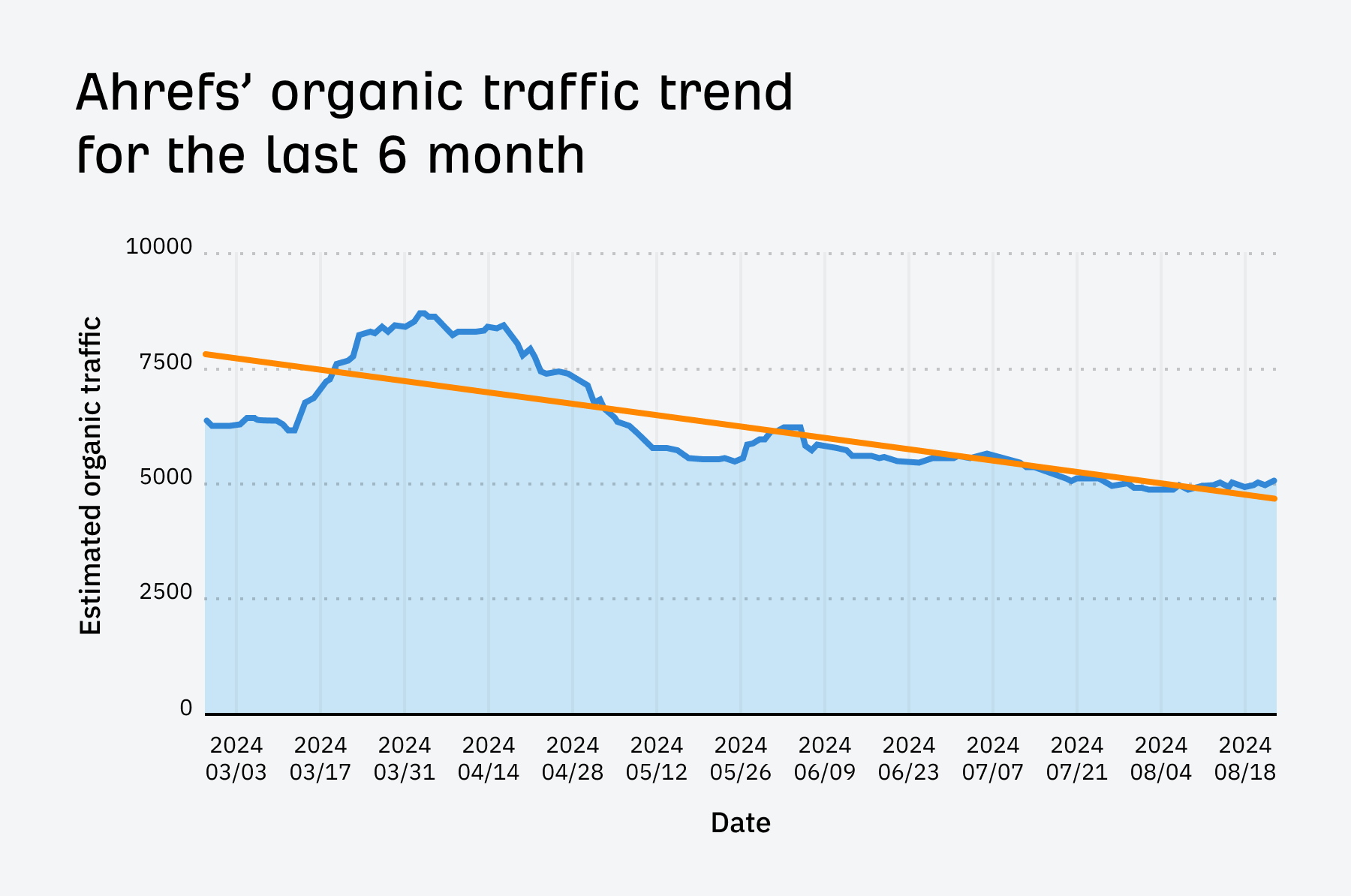

This page was our list of top YouTube searches.
For the 20-day period before the disavow, the post got 291 organic visits. This fell by 8.25% to 267 visits in the following 20 days (when the disavow was in place).
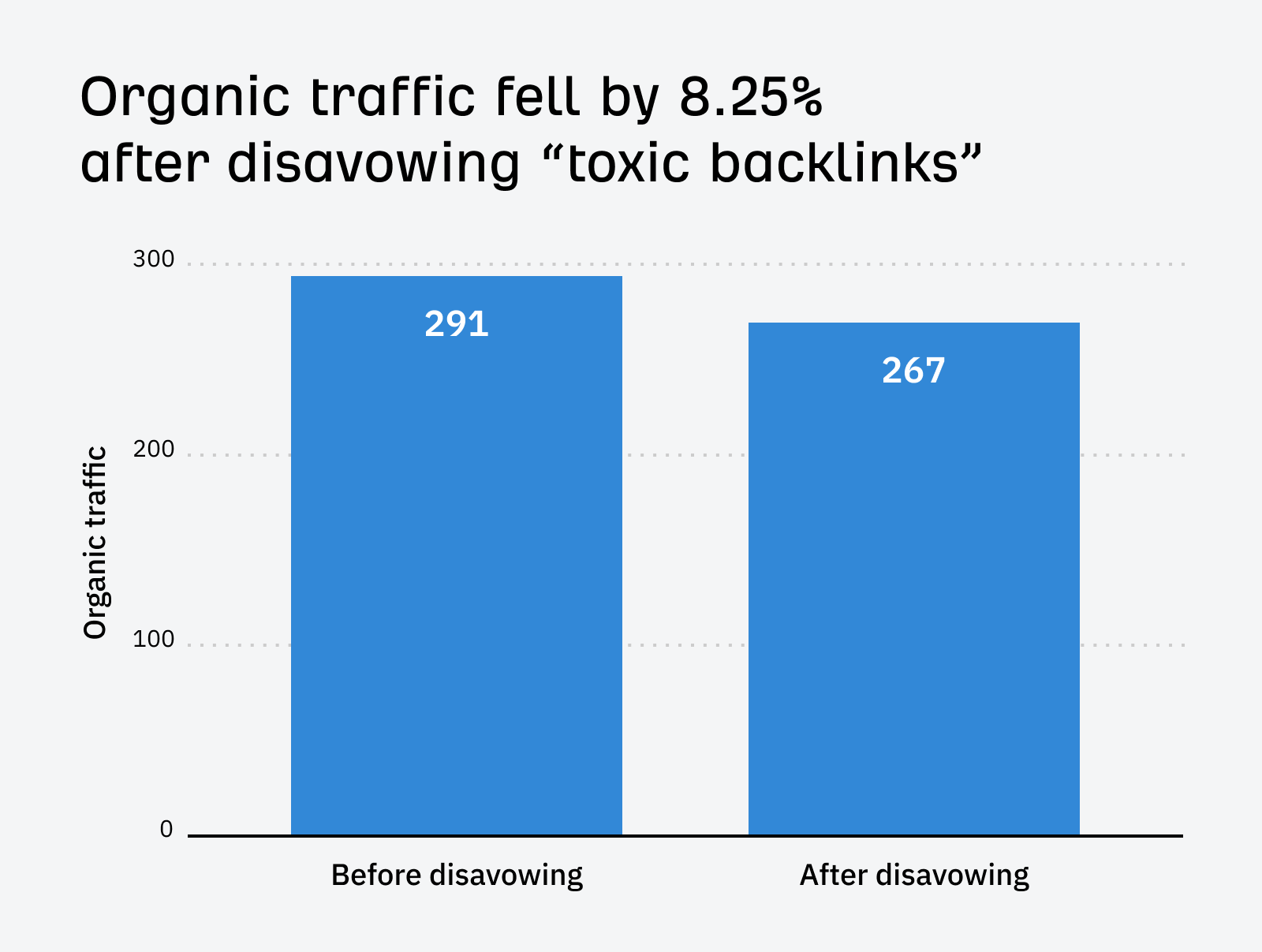

Before disavowing, organic traffic to the post was trending upward:
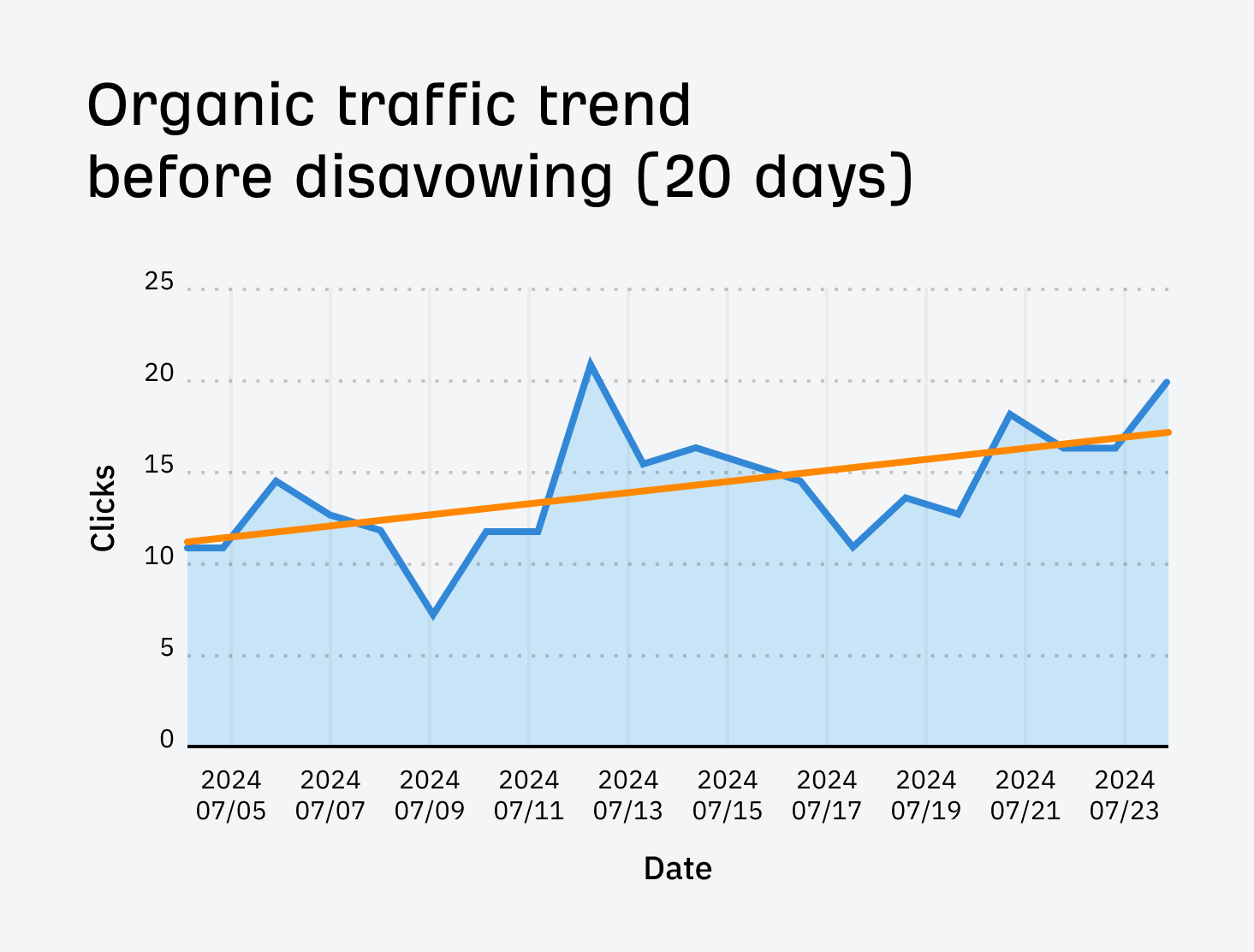

After disavowing, it’s trending downward:


Ahrefs’ data tells the same story…
Before disavowing, estimated organic traffic was trending upwards:
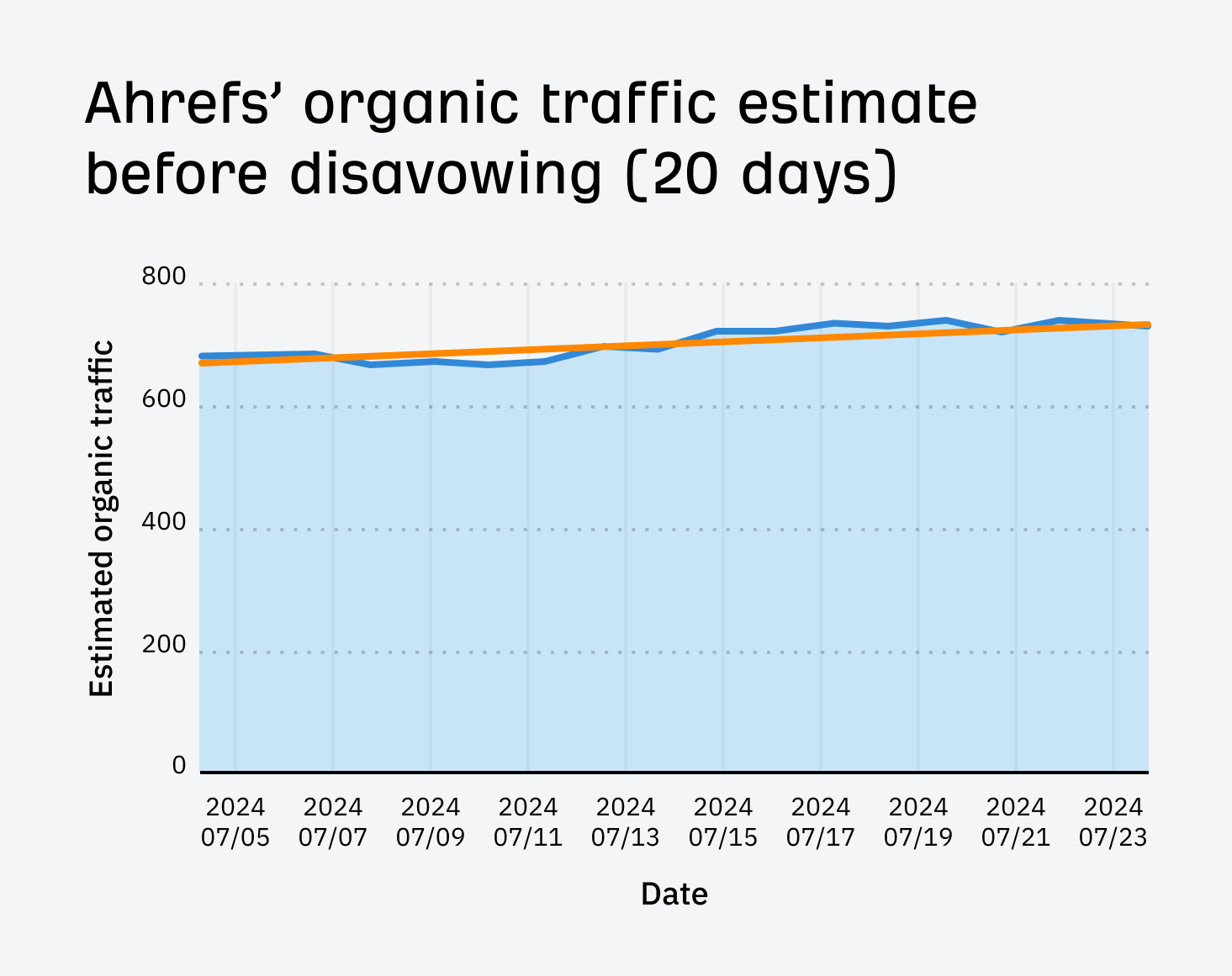

After disavowing, it’s trending downwards:


The results seem pretty clear: disavowing likely had a negative impact—especially with a big drop in estimated traffic around ten days after.
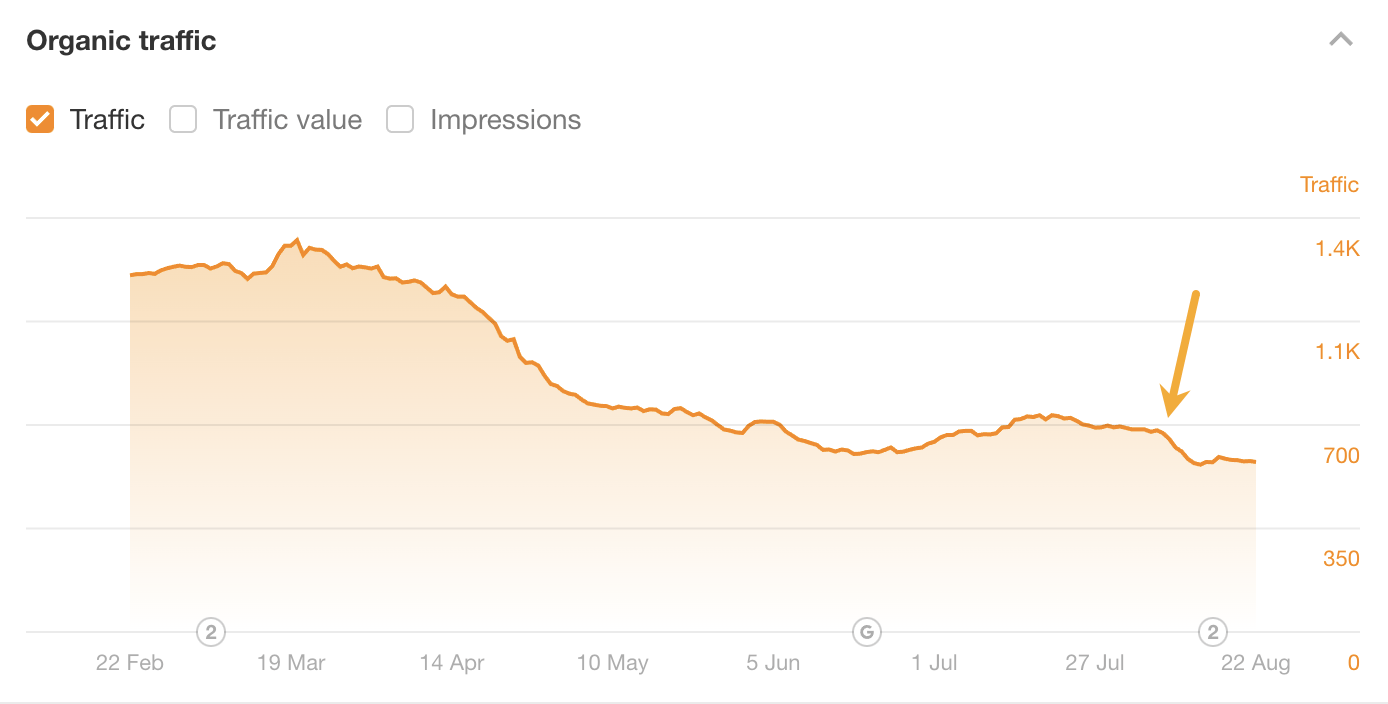

This page was our list of top Bing searches.
For the 20-day period before the disavow, the post got 156 organic visits. This grew by 12.82% to 176 visits in the following 20 days (when the disavow was in place).


Before disavowing, organic traffic to this post was trending upward:
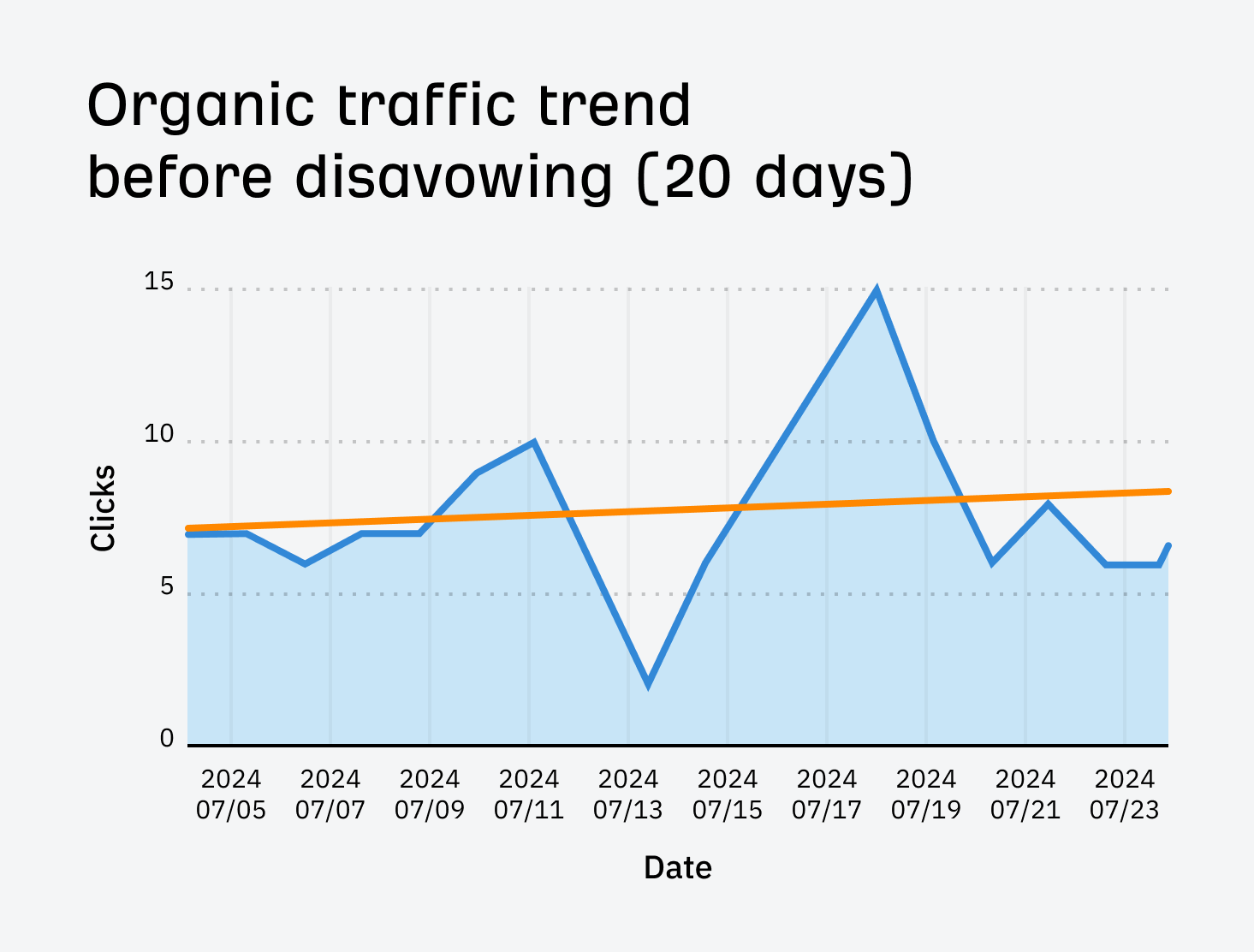

After disavowing, it’s still trending upward:


Ahrefs tells a slightly different story here…
Before disavowing, estimated traffic was trending ever so slightly (it really is slight!) downward:


After disavowing, it’s the same story:
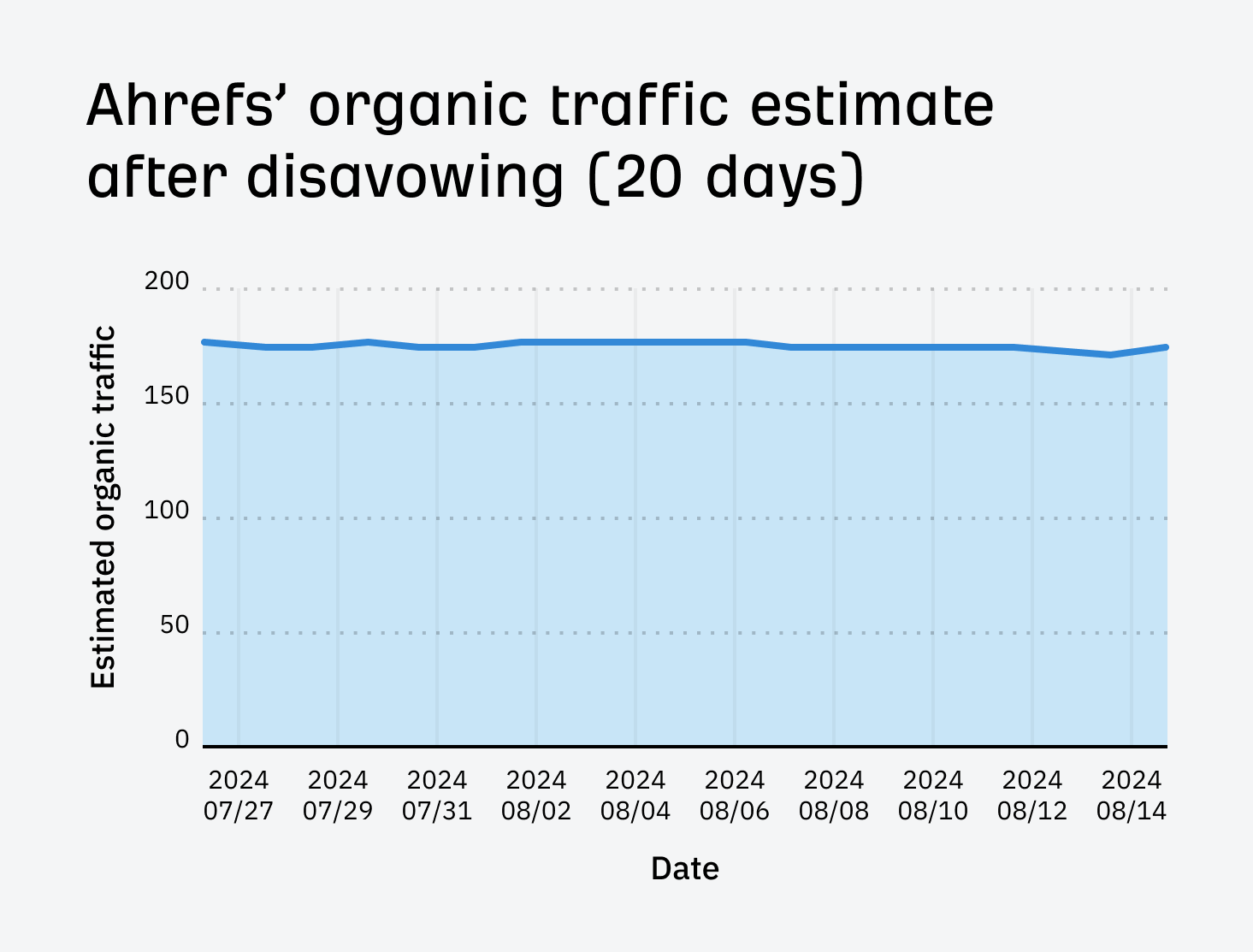

So, disavowing seemed to have little or no impact here…
What does all of this mean?
My interpretation of these results is that disavowing “toxic backlinks” basically did nothing. It seemed to hurt one page a bit, maybe slightly help another, and have no impact on another.
In short, blindly disavowing “toxic backlinks” reported by SEO tools is unlikely to have much if any positive impact—at least according to our data.
Is this a surprise? Not really. Google has been saying this pretty much forever:


That said, while the most likely outcome of disavowing is basically nothing, it’s definitely still risky. Disavowing “toxic backlinks” could tank your traffic, as this reply to John on Reddit illustrates:


Does this mean that disavowing is always a bad idea? No. If you already have a manual penalty for unnatural links or a very large number of manipulative links (e.g., paid links), then you should absolutely disavow.
Google recommends this…
You should disavow backlinks only if:
You have a considerable number of spammy, artificial, or low-quality links pointing to your site,
AND
The links have caused a manual action, or likely will cause a manual action, on your site.
… and so does Marie Haynes:
There are two situations where we will recommend to our clients a thorough link audit followed by filing a disavow:
- The site has a manual action for unnatural links in GSC.
- The site has a very large number of links that we feel the webspam team would consider to be “manipulative”.
If that’s not you, then disavowing “toxic backlinks”—especially those reported by SEO tools—probably isn’t the best idea or use of your time. As Marie Haynes said, they’re unlikely to be truly toxic anyway:
I find that the truly toxic links…the ones that could have the potential to harm your site algorithmically are rarely returned by an SEO tool.
That said, plenty of SEOs don’t agree with this advice and are convinced that disavowing “toxic backlinks” helps. If that’s you and you’re seeing good results from disavowing, fantastic! Don’t let me stop you 🙂
For everyone else, it’s probably not the best idea…
This isn’t the first time we’ve studied this either. My colleague Patrick disavowed all links to these same three posts back in 2021—and traffic fell off a cliff:


We didn’t specifically disavow “toxic” backlinks here, but links clearly still help pages rank. If an SEO tool wrongly labels some of these helpful links as “toxic” and you disavow them, it could harm your traffic.
My advice? Spend your time improving your SEO, not disavowing “toxic backlinks” that might actually be helping you!
Got questions? Disagree? Ping me on LinkedIn (or X if you insist!)
-
SEARCHENGINES7 days ago
Daily Search Forum Recap: August 23, 2024
-

 SEO6 days ago
SEO6 days agoGoogle Cautions On Improper 404 Handling
-

 SEO6 days ago
SEO6 days agoGoogle’s Revamped Documentation Shows 4 Reasons To Refresh Content
-

 WORDPRESS7 days ago
WORDPRESS7 days agoThe Magic of Federation – WordPress.com News
-
SEARCHENGINES4 days ago
Daily Search Forum Recap: August 26, 2024
-

 SEARCHENGINES6 days ago
SEARCHENGINES6 days agoGoogle Ranking Bug Fixed, August Core Update Swings, AI Overviews, Google Ads Bug & More
-

 AFFILIATE MARKETING5 days ago
AFFILIATE MARKETING5 days agoBusiness Owners are Batting 1,000 With This All-in-One Management Hub
-

 WORDPRESS5 days ago
WORDPRESS5 days agoHow to Secure Your WordPress Store







